Navigation
Install the app
How to install the app on iOS
How To Use Progressive Web App aka PWA On 420 Magazine Forum
Note: This feature may not be available in some browsers.
More options
You are using an out of date browser. It may not display this or other websites correctly.
You should upgrade or use an alternative browser.
You should upgrade or use an alternative browser.
Indicas Grow & Experimenting Genetics Part II - Winter Indoor Organic Grow
- Thread starter Danishoes21
- Start date
- Thread starter
- #42
Danishoes21
Well-Known Member
This might explain the odd necrosis on leafs of my now 2 month old Blue Berry (most of the time big fan leaves). I would think is some sort of nut deficiency or overdose but I don't really use bottle fertilizer, PH fluctuation are discarded because none of the other plants show the same leaf necrosis. Two things could be happening, leaf defence mechanism to pathogens in the environment or hormonal change within plant is causing necrotic cell death on the older leafs. There seems to be a increase in the formation of trichomes in all the 3 leaflet leafs rather than the 5 leaflet leafs that seem to be naturally dying. Now you can see build up trichomes on the stem, leafs, under the leafs, not just on the pistils or the young calyx forming. The upward growth seems to had slowed considerable in two weeks she only grew 1 cm on the Top cola, but bottom growth seems to be catching up and also the trichomes seem to be developing. Does it mean MORE and BETTER THC content we will only know once we actually consume the plant.... (long time ahead)
This brings me to another question, What if we maintained this photoperiod for a long duration, let say 6 months or 12 months of 14 hrs photoperiod? What are the effects on trichomes and THC development?
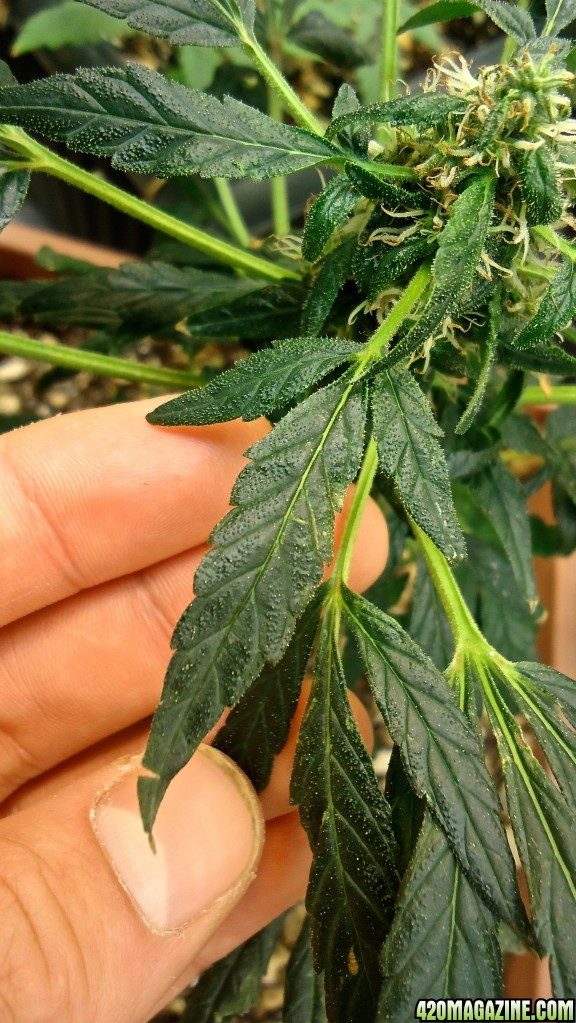
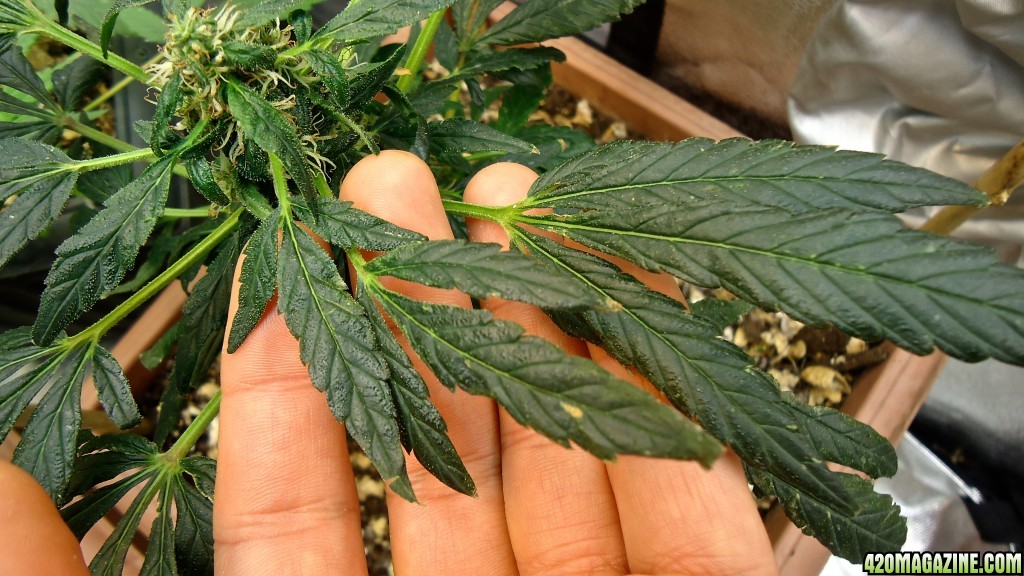
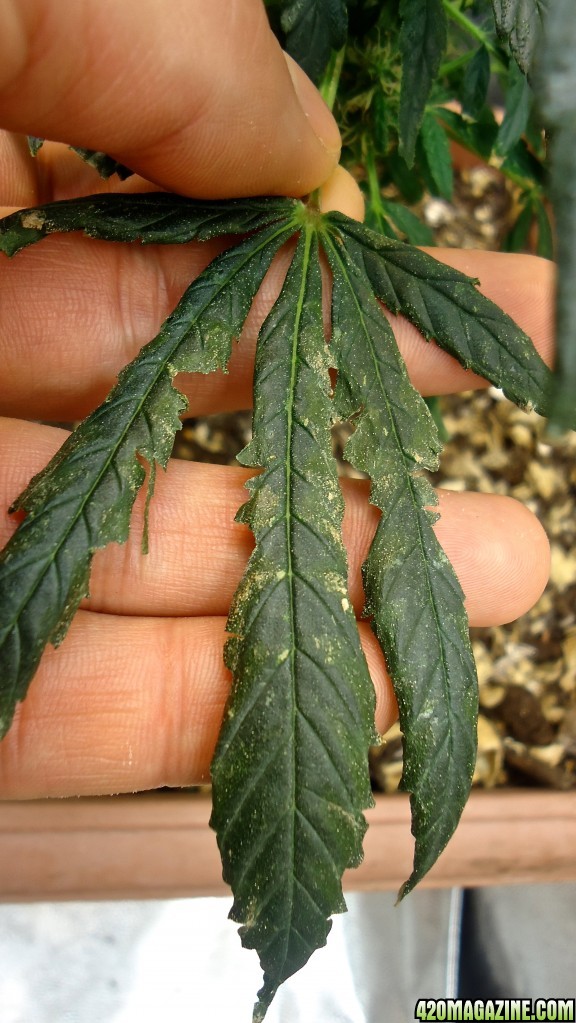
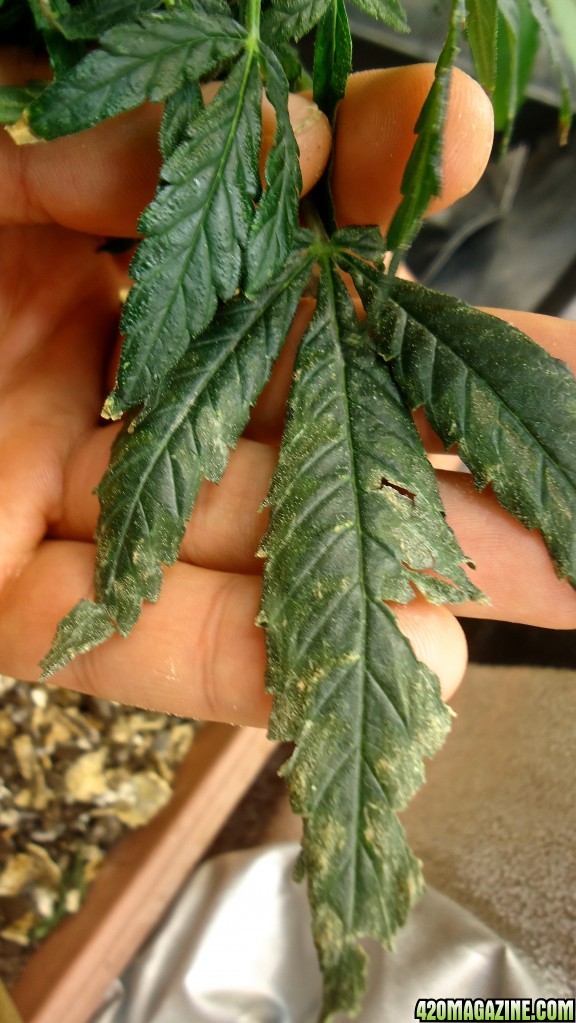
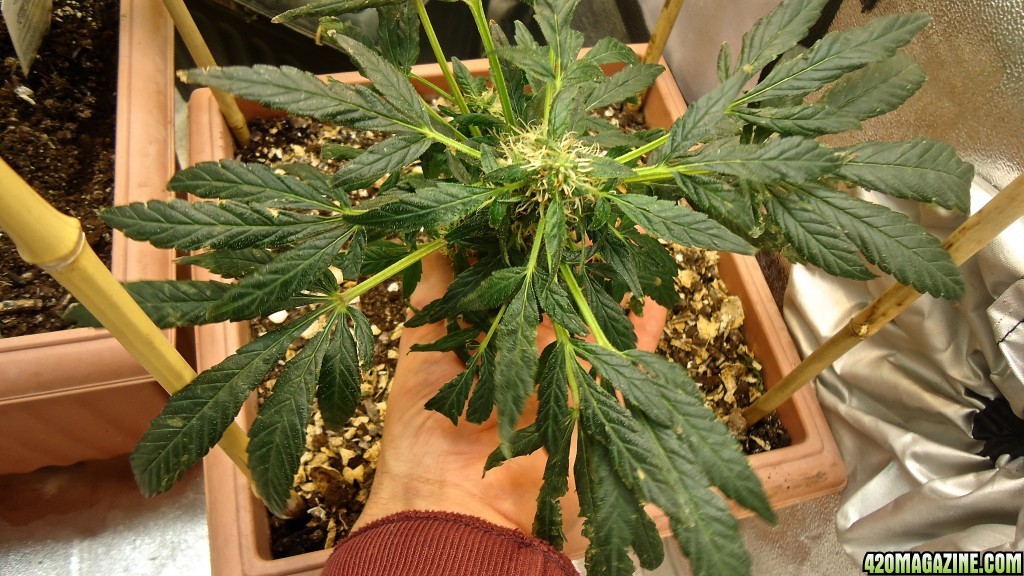
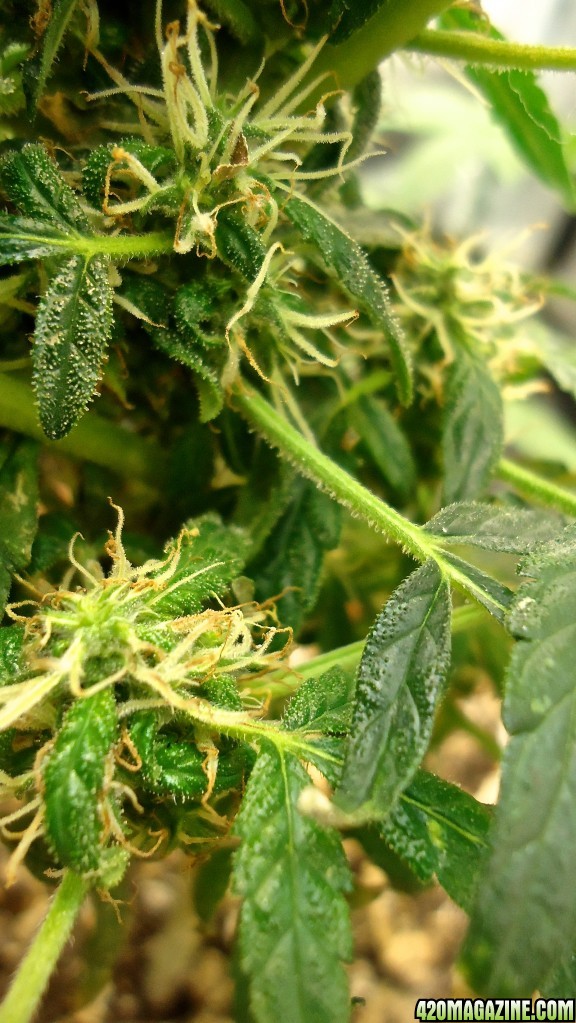
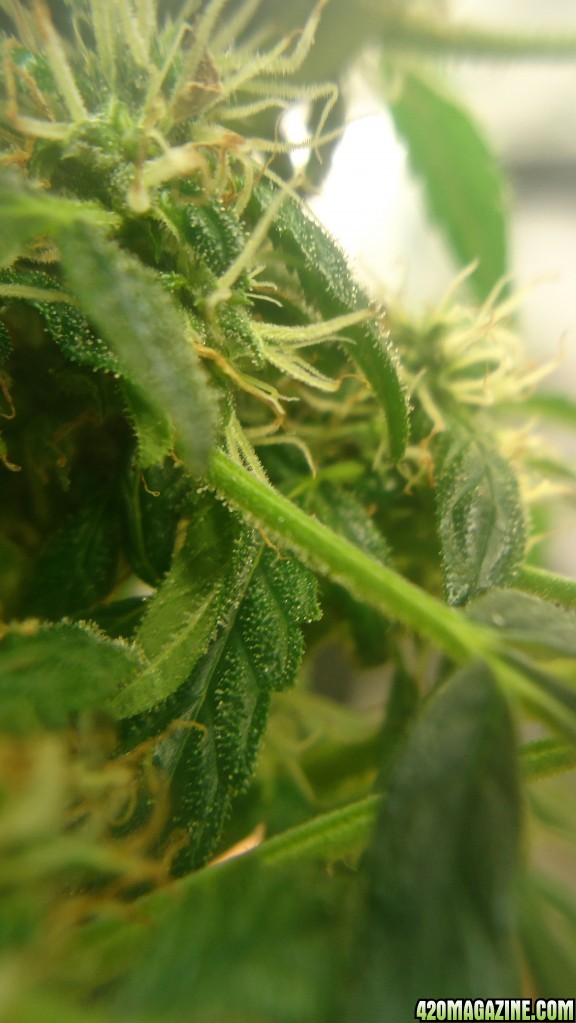
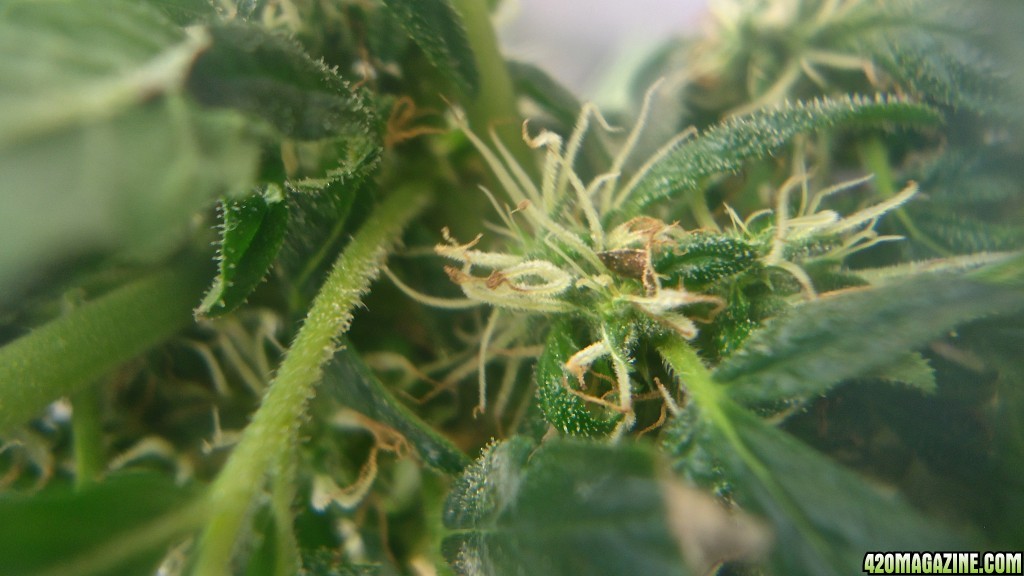
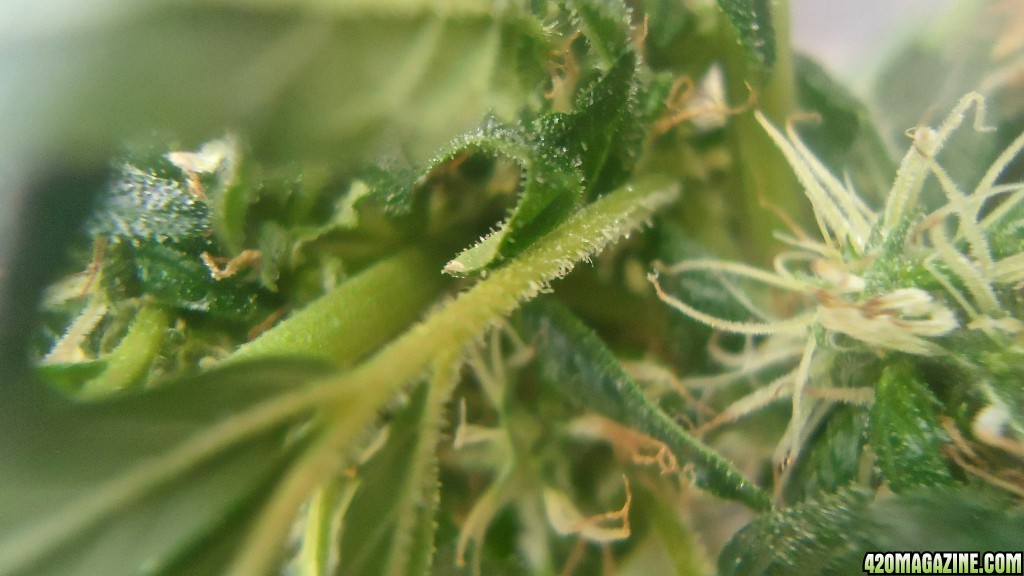
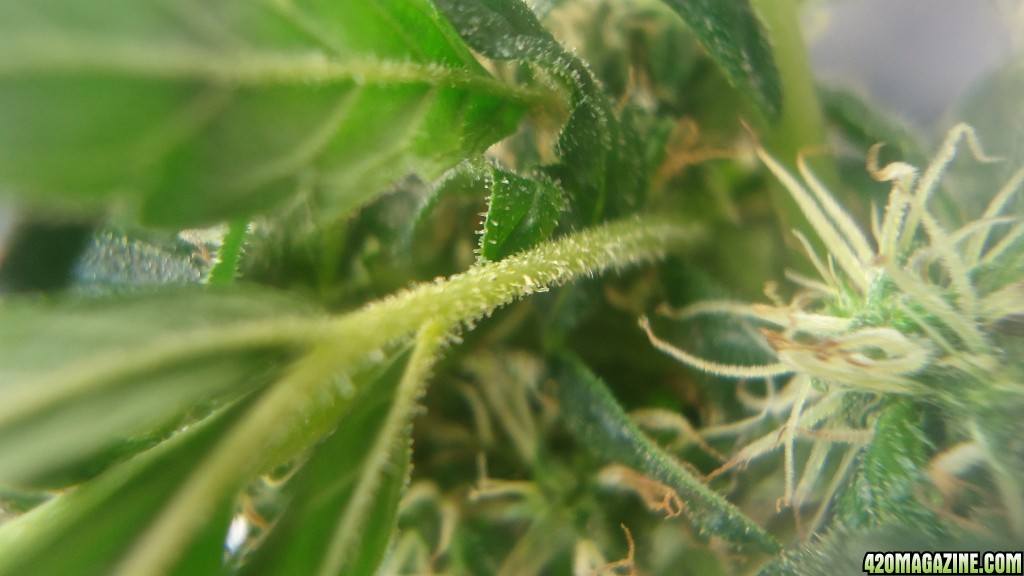
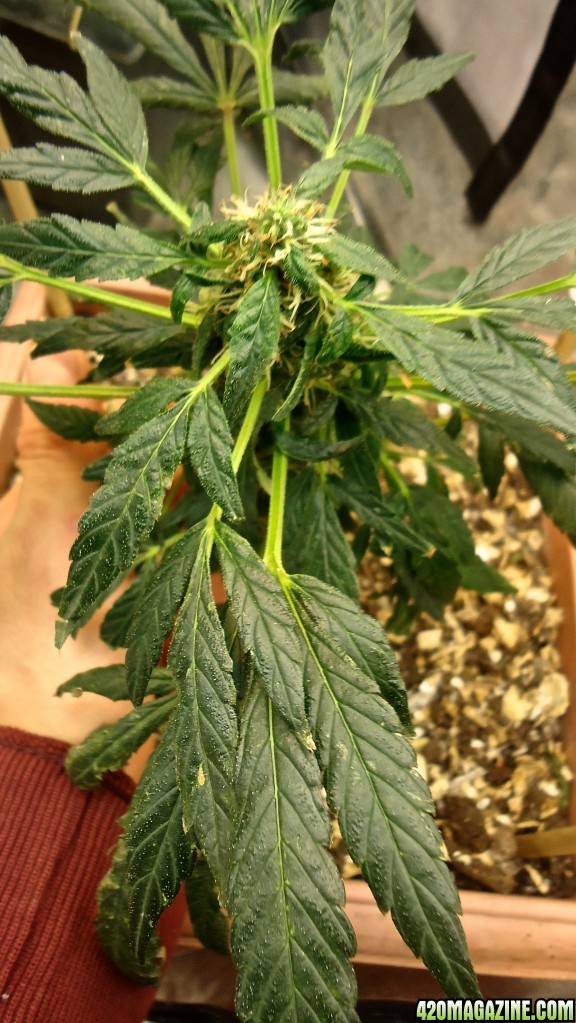
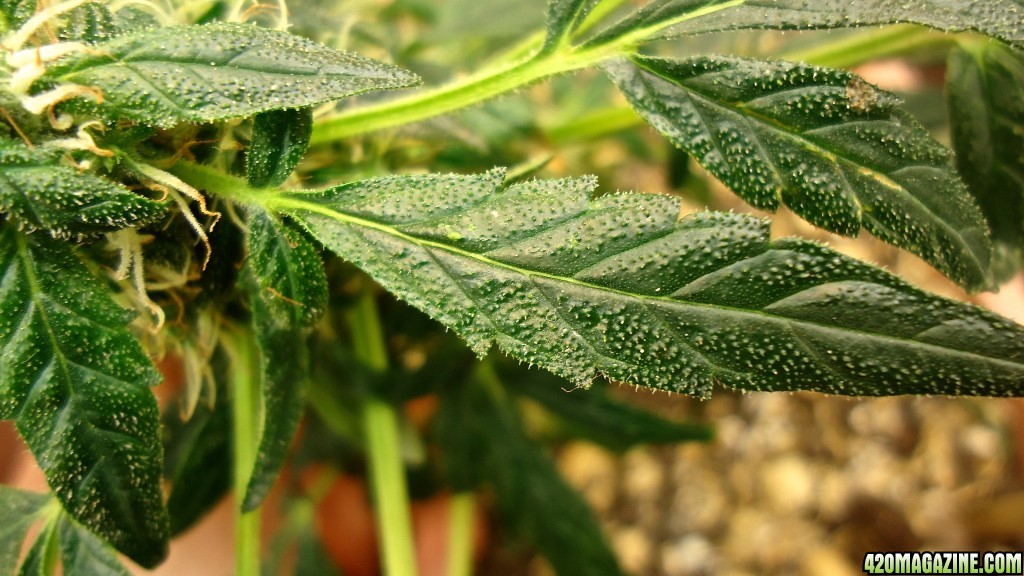
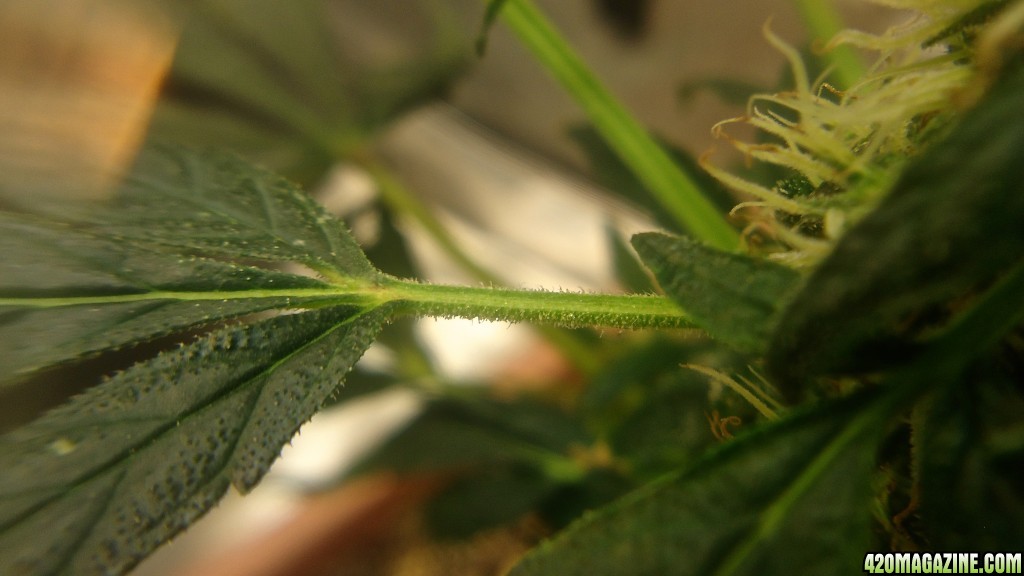
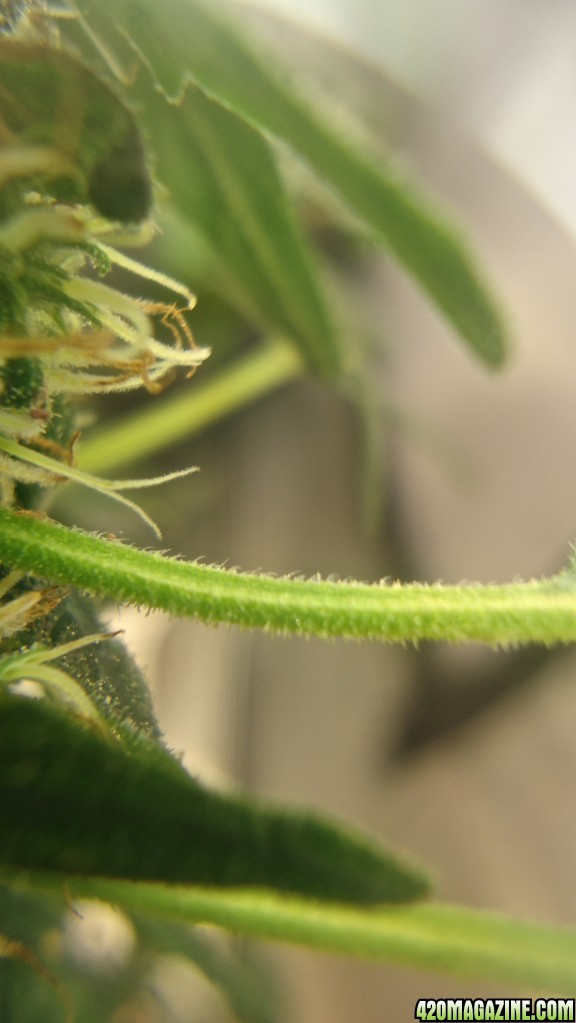
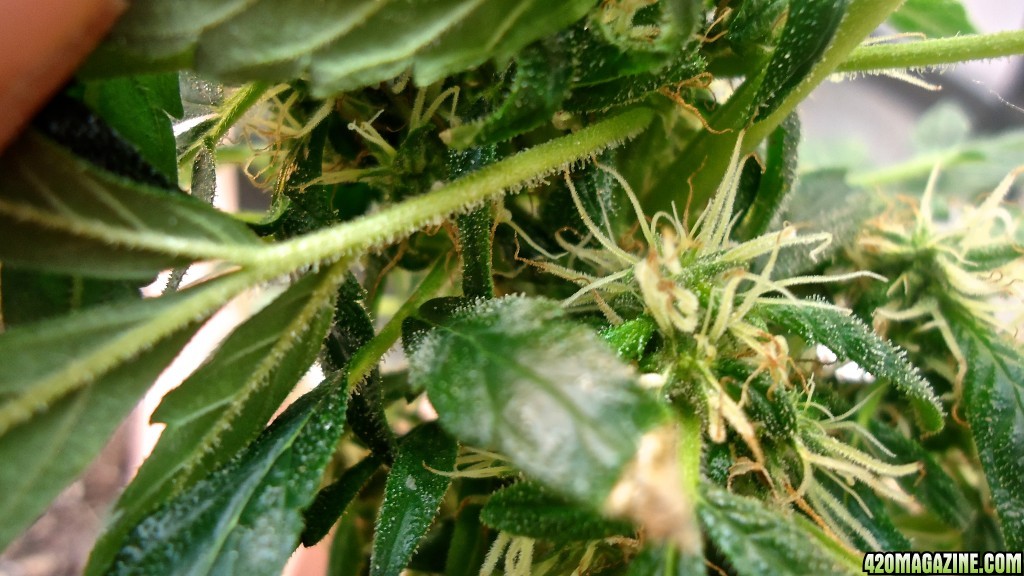
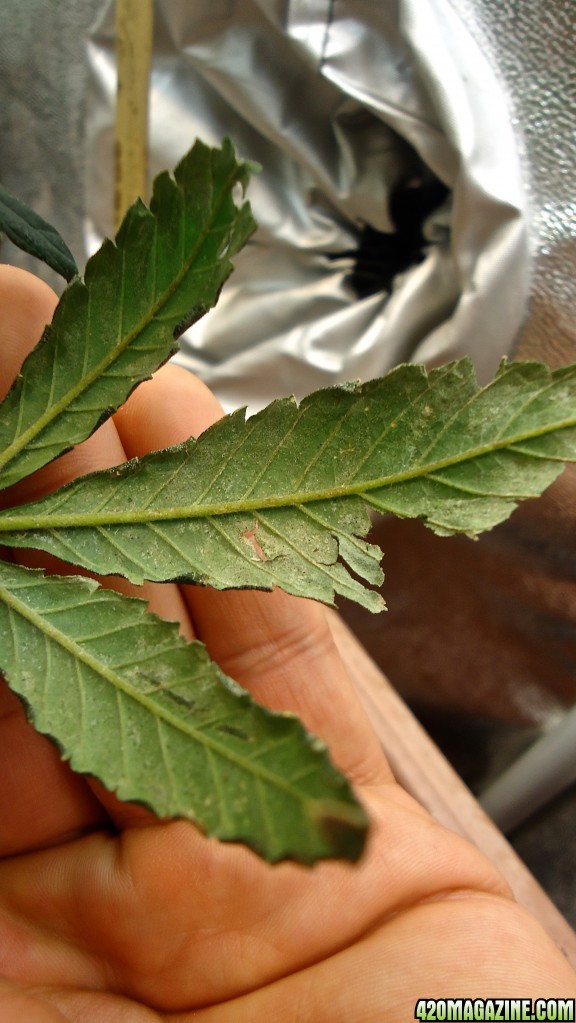
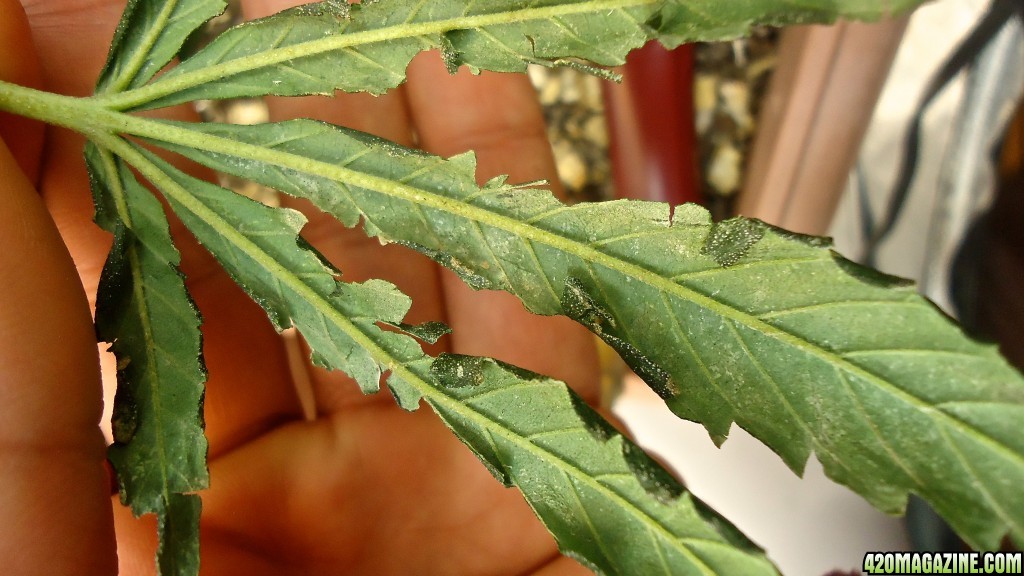
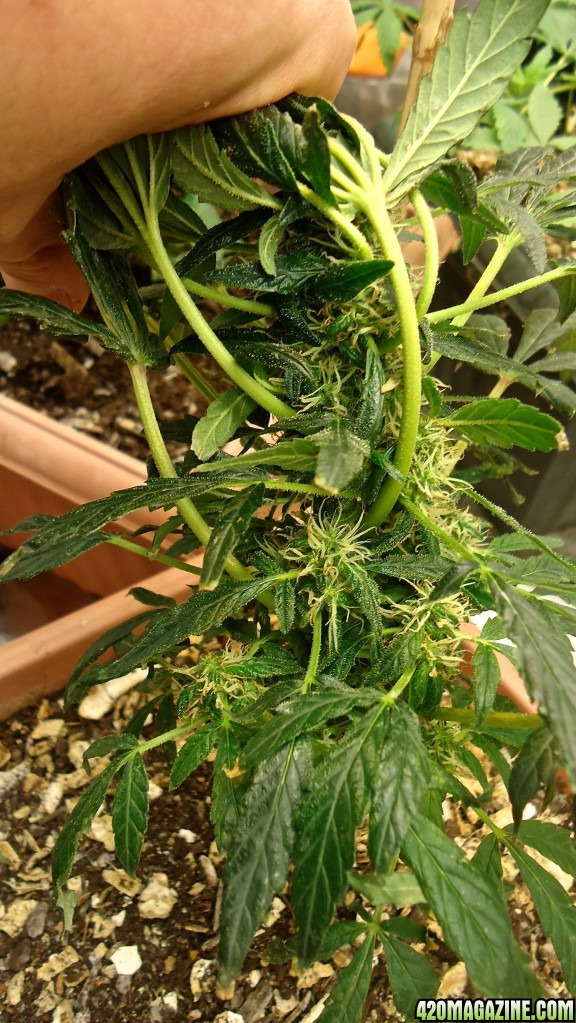
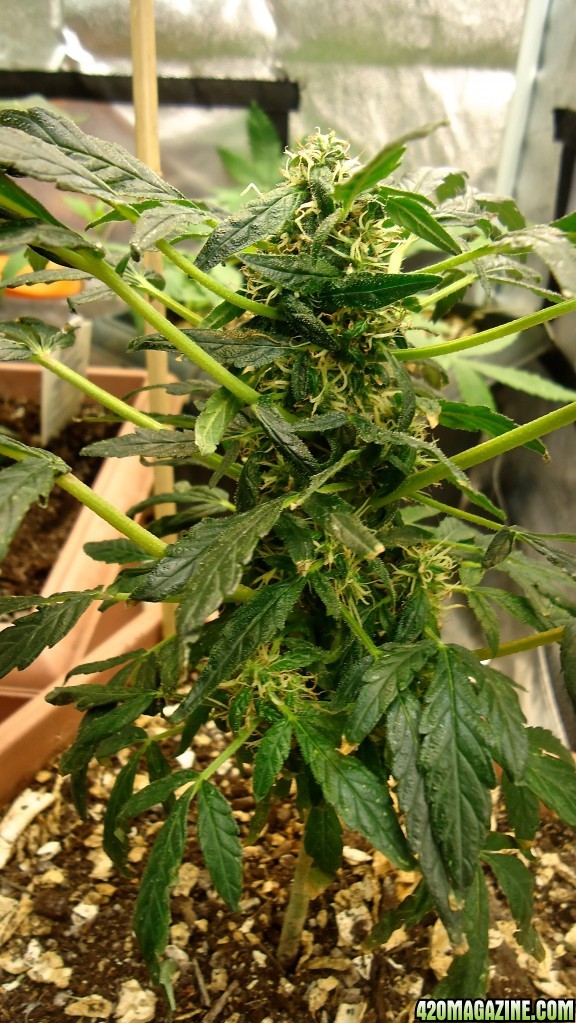
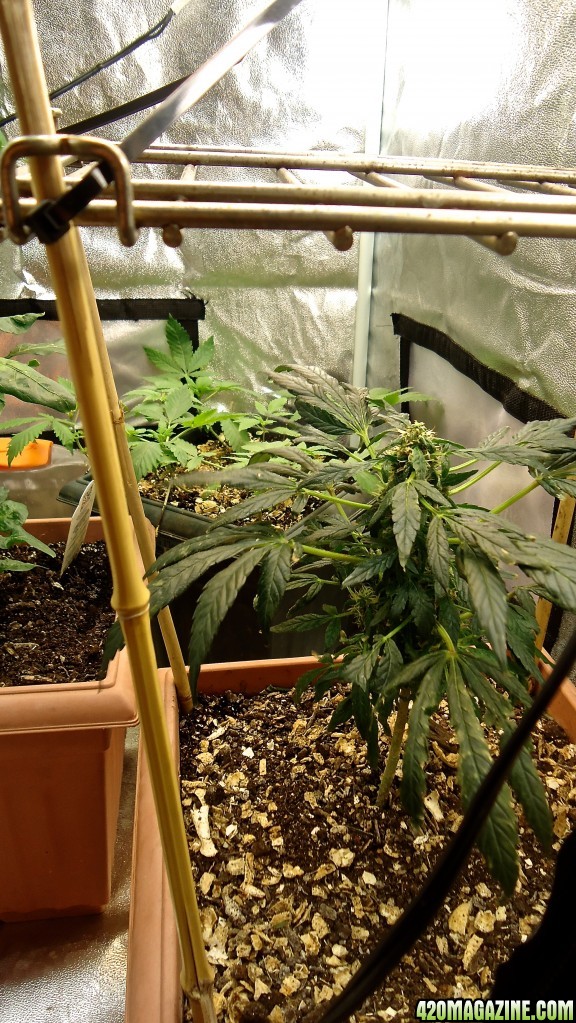
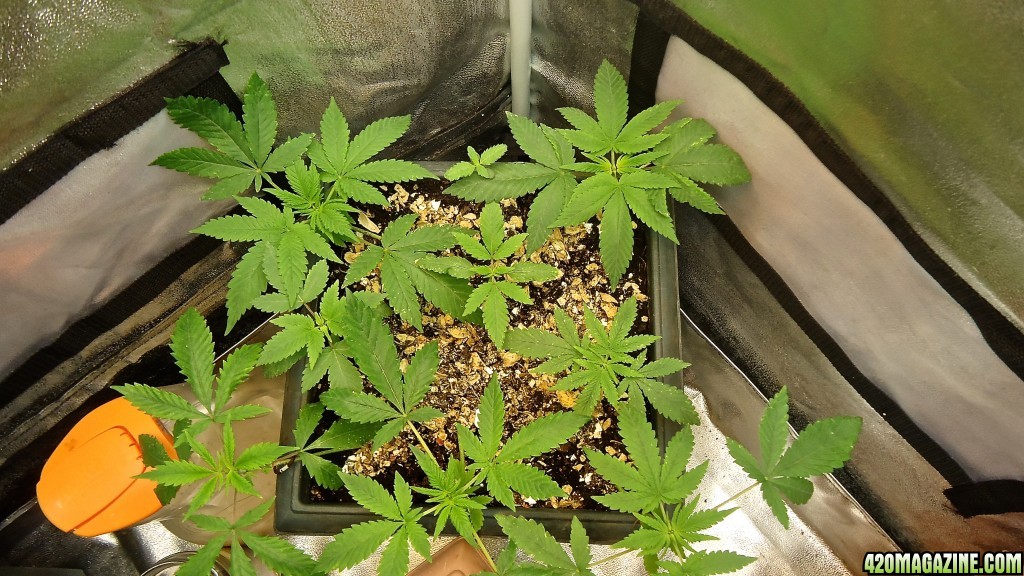
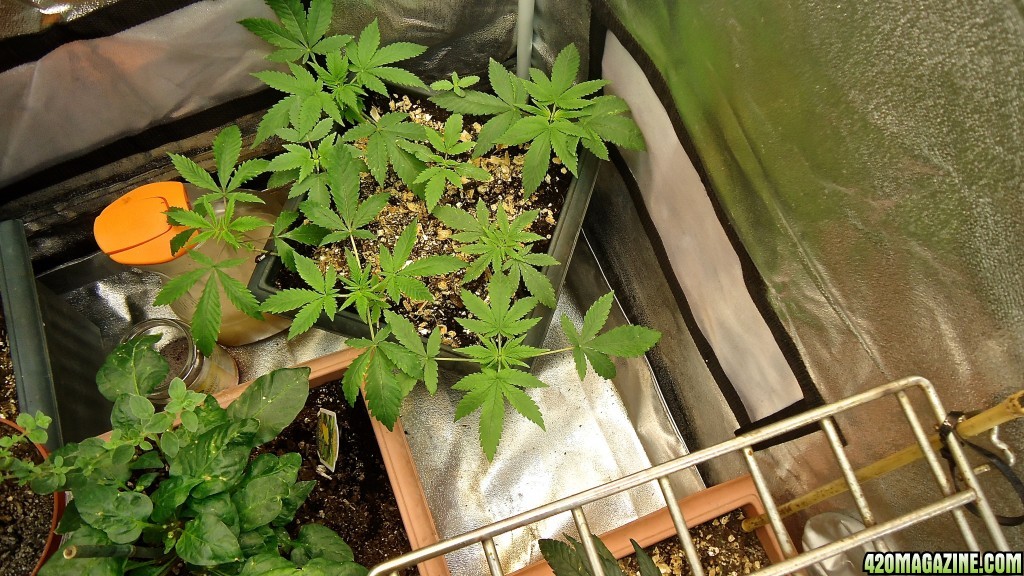
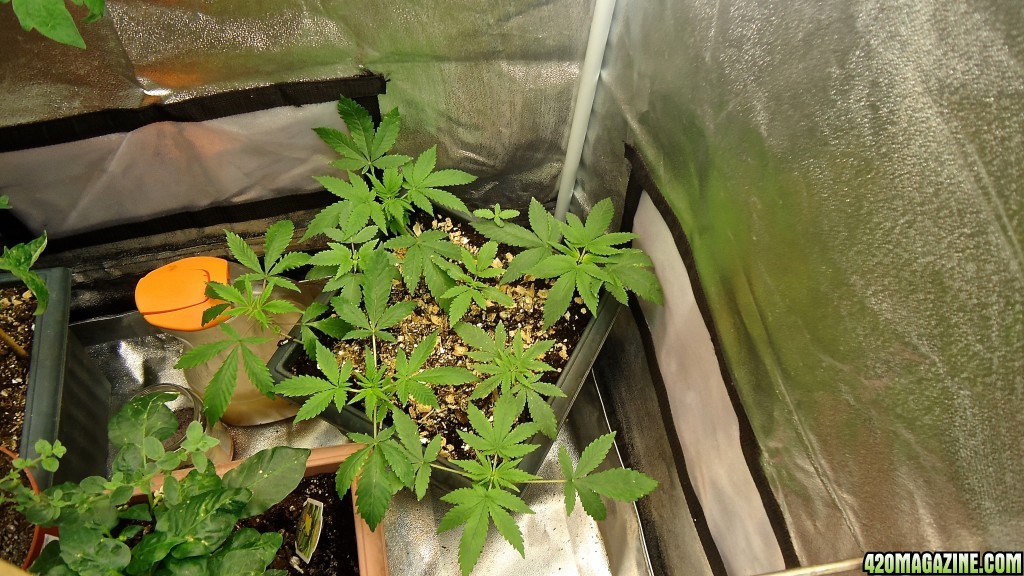
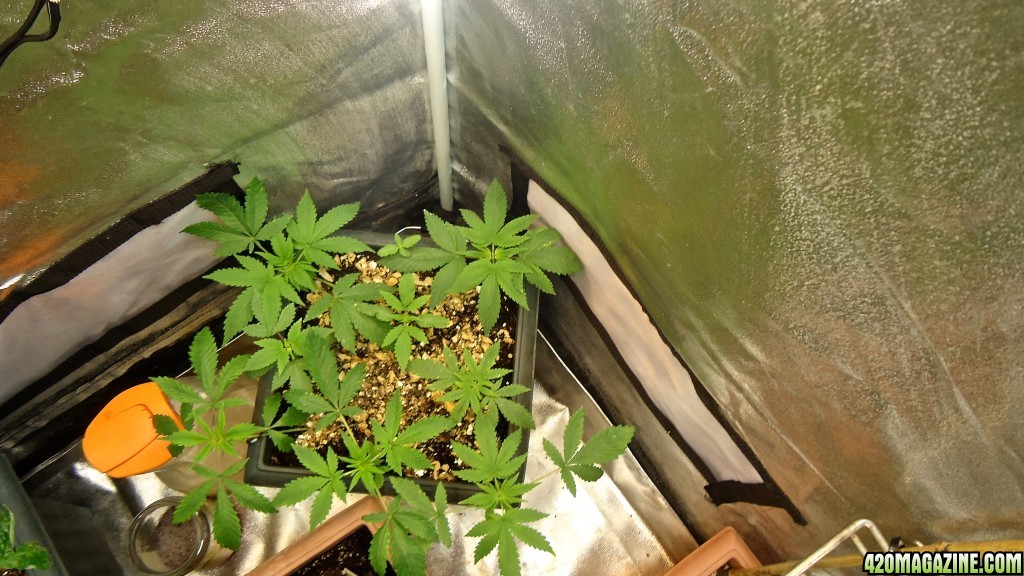
Abstract
"Cannabis sativa is well known to produce unique secondary metabolites called cannabinoids. We recently discovered that Cannabis leaves induce cell death by secreting tetrahydrocannabinolic acid (THCA) into leaf tissues. Examinations using isolated Cannabis mitochondria demonstrated that THCA causes mitochondrial permeability transition (MPT) though opening of MPT pores, resulting in mitochondrial dysfunction (the important feature of necrosis). Although Ca2+ is known to cause opening of animal MPT pores, THCA directly opened Cannabis MPT pores in the absence of Ca2+. Based on these results, we conclude that THCA has the ability to induce necrosis though MPT in Cannabis leaves, independently of Ca2+. We confirmed that other cannabinoids (cannabidiolic acid and cannabigerolic acid) also have MPT-inducing activity similar to that of THCA. Moreover, mitochondria of plants which do not produce cannabinoids were shown to induce MPT by THCA treatment, thus suggesting that many higher plants may have systems to cause THCA-dependent necrosis.
Addendum to: Morimoto S, Tanaka Y, Sasaki K, Tanaka H, Fukamizu T, Shoyama Y, Shoyama Y, Taura F. Identification and characterization of cannabinoids that induce cell death through mitochondrial permeability transition in Cannabis leaf cells. J Biol Chem 2007; 282:20739-51.
Cannabis sativa produces unique secondary metabolites consisting of alkylresorcinol and monoterpene groups.1 These metabolites called cannabinoids are well known to show a variety of interesting pharmacological activities including psychoactive effect and analgesic effect. Therefore, cannabinoids have attracted a great deal of attention, whereas why C. sativa produces such metabolites has long remained unclear. However, we have recently obtained evidences indicating the physiological function of THCA in Cannabis leaves.
We discovered that THCA is stored in capitate-sessile glands on Cannabis leaves and that secretion of this cannabinoid into leaf tissues causes cell death. When the properties of THCA were examined using cultured Cannabis cells, this cannabinoid induced plasmamembrane shrinkage and DNA degradation. These responses are regarded as the features of apoptotic cells, but were not suppressed by apoptosis inhibitors. In contrast, the necrosis inhibitor cyclosporine A significantly inhibited both plasmamembrane shrinkage and DNA degradation in Cannabis cells. Therefore, we assumed that THCA induces necrotic cell death in Cannabis cells and leaves.
Necrosis in plants and animals is usually triggered by MPT though opening of MPT pores.3,4 MPT is known to cause mitochondrial dysfunction by mitochondrial swelling and loss of mitochondrial membrane potential (ΔΨm),5,6 and we also confirmed that THCA induces mitochondrial swelling and ΔΨm reduction in mitochondria isolated from Cannabis cells and that pretreatment with cyclosporine A inhibits both responses. Based on these evidences, we concluded that THCA has the activity to induce MPT-dependent necrosis.
As described above, MPT pores play an important role in necrosis induction, whereas the mechanism of their opening in higher plants has not been fully understood. However, binding of cyclophilin D (a protein present in mitochondrial matrix) to MPT pores is shown to be essential for their opening in plants as well as animal.7—9 In animal mitochondria, Ca2+ mediates this binding reaction, leading to opening of MPT pores. Wheat mitochondria are also shown to undergo swelling through opening of MPT pores in response to Ca2+,9 whereas MPT pores of oats,10 Arabidopsis thaliana11 and C. sativa2 do not open by Ca2+ treatment. In contrast, THCA catalyzed opening of Cannabis MPT pores in the absence of Ca2+, suggesting that THCA directly mediates binding of cyclophilin D to MPT pores (Fig. 1). In addition, we have now confirmed that THCA causes dysfunction though MPT in mitochondria of plants (rice, soybean, A. thaliana and Scutellaria baicalensis) lacking cannabinoid-producing ability (data not shown). Therefore, many higher plants may have the systems to induce THCA-dependent necrosis.
Furthermore, we investigated whether other cannabinoids and their related compounds can mediate MPT in Cannabis mitochondria. When the MPT-inducing activity of each sample was measured by monitoring both ΔΨm reduction (Fig. 2) and mitochondrial swelling (data not shown), we confirmed that cannabinoids tested here (cannabidiolic acid and cannabigerolic acid) possess the activities similar to those of THCA. On the other hand, olivetolic acid (the akylresorcinol moiety of cannabinoid) and geraniol (the monoterpene moiety of cannabigerolic acid) showed neither ΔΨm reduction nor mitochondrial swelling (Fig. 2). These results suggested that the structures (cannabinoid skeleton) where monoterpene and olivetolic acid are coupled to each other seem essential for opening of MPT pores. Therefore, we assumed that plant cyclophilin D and MPT pores have the cannabinoid-binding site.
Plant cell death is shown to participate in important physiological responses such as leaf senescence, somatic embryogenesis and defense against microbial pathogens.12,13 Based on its induction mechanism, plant cell death is largely classified into apoptosis and necrosis. Although the molecular mechanism of apoptosis has been extensively investigated, there is little precise information on plant necrosis. However, our study would provide important insight into necrosis-inducing mechanisms in higher plants."
This brings me to another question, What if we maintained this photoperiod for a long duration, let say 6 months or 12 months of 14 hrs photoperiod? What are the effects on trichomes and THC development?
Abstract
"Cannabis sativa is well known to produce unique secondary metabolites called cannabinoids. We recently discovered that Cannabis leaves induce cell death by secreting tetrahydrocannabinolic acid (THCA) into leaf tissues. Examinations using isolated Cannabis mitochondria demonstrated that THCA causes mitochondrial permeability transition (MPT) though opening of MPT pores, resulting in mitochondrial dysfunction (the important feature of necrosis). Although Ca2+ is known to cause opening of animal MPT pores, THCA directly opened Cannabis MPT pores in the absence of Ca2+. Based on these results, we conclude that THCA has the ability to induce necrosis though MPT in Cannabis leaves, independently of Ca2+. We confirmed that other cannabinoids (cannabidiolic acid and cannabigerolic acid) also have MPT-inducing activity similar to that of THCA. Moreover, mitochondria of plants which do not produce cannabinoids were shown to induce MPT by THCA treatment, thus suggesting that many higher plants may have systems to cause THCA-dependent necrosis.
Addendum to: Morimoto S, Tanaka Y, Sasaki K, Tanaka H, Fukamizu T, Shoyama Y, Shoyama Y, Taura F. Identification and characterization of cannabinoids that induce cell death through mitochondrial permeability transition in Cannabis leaf cells. J Biol Chem 2007; 282:20739-51.
Cannabis sativa produces unique secondary metabolites consisting of alkylresorcinol and monoterpene groups.1 These metabolites called cannabinoids are well known to show a variety of interesting pharmacological activities including psychoactive effect and analgesic effect. Therefore, cannabinoids have attracted a great deal of attention, whereas why C. sativa produces such metabolites has long remained unclear. However, we have recently obtained evidences indicating the physiological function of THCA in Cannabis leaves.
We discovered that THCA is stored in capitate-sessile glands on Cannabis leaves and that secretion of this cannabinoid into leaf tissues causes cell death. When the properties of THCA were examined using cultured Cannabis cells, this cannabinoid induced plasmamembrane shrinkage and DNA degradation. These responses are regarded as the features of apoptotic cells, but were not suppressed by apoptosis inhibitors. In contrast, the necrosis inhibitor cyclosporine A significantly inhibited both plasmamembrane shrinkage and DNA degradation in Cannabis cells. Therefore, we assumed that THCA induces necrotic cell death in Cannabis cells and leaves.
Necrosis in plants and animals is usually triggered by MPT though opening of MPT pores.3,4 MPT is known to cause mitochondrial dysfunction by mitochondrial swelling and loss of mitochondrial membrane potential (ΔΨm),5,6 and we also confirmed that THCA induces mitochondrial swelling and ΔΨm reduction in mitochondria isolated from Cannabis cells and that pretreatment with cyclosporine A inhibits both responses. Based on these evidences, we concluded that THCA has the activity to induce MPT-dependent necrosis.
As described above, MPT pores play an important role in necrosis induction, whereas the mechanism of their opening in higher plants has not been fully understood. However, binding of cyclophilin D (a protein present in mitochondrial matrix) to MPT pores is shown to be essential for their opening in plants as well as animal.7—9 In animal mitochondria, Ca2+ mediates this binding reaction, leading to opening of MPT pores. Wheat mitochondria are also shown to undergo swelling through opening of MPT pores in response to Ca2+,9 whereas MPT pores of oats,10 Arabidopsis thaliana11 and C. sativa2 do not open by Ca2+ treatment. In contrast, THCA catalyzed opening of Cannabis MPT pores in the absence of Ca2+, suggesting that THCA directly mediates binding of cyclophilin D to MPT pores (Fig. 1). In addition, we have now confirmed that THCA causes dysfunction though MPT in mitochondria of plants (rice, soybean, A. thaliana and Scutellaria baicalensis) lacking cannabinoid-producing ability (data not shown). Therefore, many higher plants may have the systems to induce THCA-dependent necrosis.
Furthermore, we investigated whether other cannabinoids and their related compounds can mediate MPT in Cannabis mitochondria. When the MPT-inducing activity of each sample was measured by monitoring both ΔΨm reduction (Fig. 2) and mitochondrial swelling (data not shown), we confirmed that cannabinoids tested here (cannabidiolic acid and cannabigerolic acid) possess the activities similar to those of THCA. On the other hand, olivetolic acid (the akylresorcinol moiety of cannabinoid) and geraniol (the monoterpene moiety of cannabigerolic acid) showed neither ΔΨm reduction nor mitochondrial swelling (Fig. 2). These results suggested that the structures (cannabinoid skeleton) where monoterpene and olivetolic acid are coupled to each other seem essential for opening of MPT pores. Therefore, we assumed that plant cyclophilin D and MPT pores have the cannabinoid-binding site.
Plant cell death is shown to participate in important physiological responses such as leaf senescence, somatic embryogenesis and defense against microbial pathogens.12,13 Based on its induction mechanism, plant cell death is largely classified into apoptosis and necrosis. Although the molecular mechanism of apoptosis has been extensively investigated, there is little precise information on plant necrosis. However, our study would provide important insight into necrosis-inducing mechanisms in higher plants."
- Thread starter
- #43
Danishoes21
Well-Known Member
looking good and I hope the uv bulb helps you create even stronger plantsremember that fluorescent lighting should be placed within 6" of your plants.
Thanks for the good vibes B.
The whole UV experiment is something Im eager to discover. In a normal outdoor situation plants and all living things are naturally exposed to UVA and UVB radiation UVC is totally absorbed by the Atmosphere. Lights for indoor grows don't radiate UV because its unsafe for humans to use. But then you take out a variable (UV) of the photosynthetic equation by not exposition plant cells to a controlled amount of UV radiation?? that my hypothesis...
the amount of UV index??
the time of exposure ??
stuff we gonna try to figure out in this journal... There is a high % of affecting my plants (good or bad) don't know yet.
- Thread starter
- #44
Danishoes21
Well-Known Member
The addition of UVB to the spectrum of led lights for example could be a great addition to the spectrum of light they emit, because there is a pattern I have seen in most of the LED grows on the site right now, is these light tend to cause a Ca and Mg deficiency... why? I haven't really gone deep into why the NEW leds cause this deficiencies.
- Thread starter
- #45
Danishoes21
Well-Known Member
if you guys have the time and willpower, this is a good reading to understanding cannabis beyond the smoke and the toke (which we all love don't we) 

- Thread starter
- #47
Danishoes21
Well-Known Member
fluorescents actually burn at uv levels and are sold as germicidal lamps. it isn't until the addition of phosphor that they illuminate at visible levels. I think hid lamps and leds also emit uv light.
According to the spectrum charts the usually don't go bellow 380nm because thats lowest useful light wave in cannabis growing but the UVB wave goes as low as 280nm. As I say I don't use LED nor HID so Im no expert but the charts are there to see. Natural sunlight does emit UVA UVB UVC this last one totally filtered by the atmosphere, UVA and UVB are also filter but rays are still available to pass the atmosphere filter, UVB is invisible to our eyes so we can only feel the radiation (like a sunburn on the skin or that awfull feel after staring directly at the sun). Im just saying if we could apply more of this radiation without actually harming the plant this could in some sort rearrange the whole cannabinoids structure... its just a thought I can't really proof anything until Im done with the session like 3 more months LOL... Unless I kill all of them in the first weeks to exposure.
- Thread starter
- #48
Danishoes21
Well-Known Member
Germicidal lamps are mostly UVC that go below 280nm at that point it sterilizes killing all living cells. They use lamp with this light for sterilization of medical equipment, sterilization of water, even air... so UVC is not of use for growing plants.
The exact wavelength I want to explore is from 280nm-320nm
The exact wavelength I want to explore is from 280nm-320nm
- Thread starter
- #49
Danishoes21
Well-Known Member
You recently changed to LED, you can probably help me out on this one B.
- Thread starter
- #50
Danishoes21
Well-Known Member
Update.
I want to show each individual phenotype, there are only 3 types of "genes" yet more than 3 different phenotype, they all look like different "strains". Very green, vibrant, each growing at their own pace, no signs of sex yet. Also no signs of 3 leaflet leaf, I could even count one fan leaf has 7 leaflet. So clearly these are all young plants still have not trigger flowering hormones to the mix, no visible trichome development at this point. First month
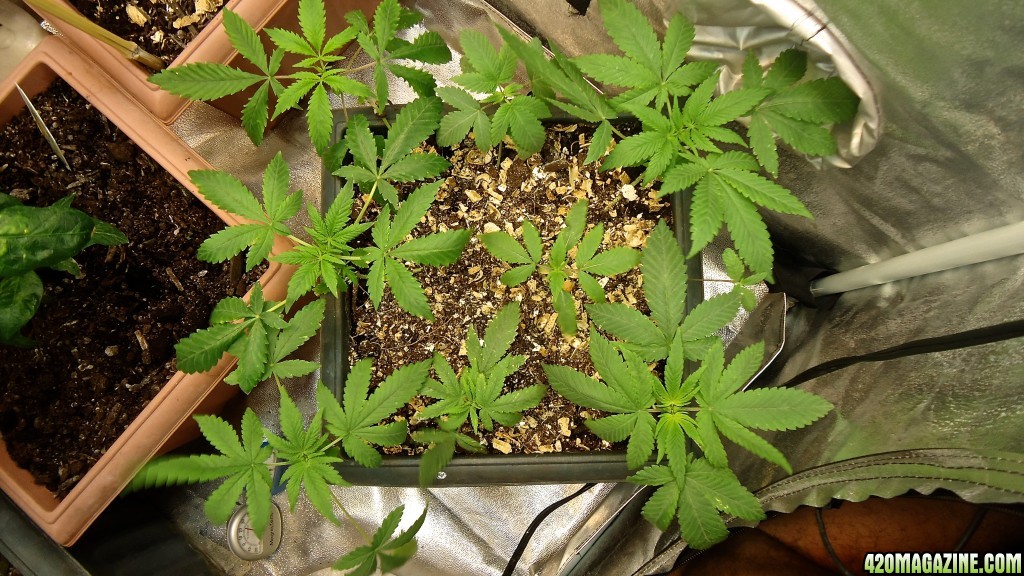
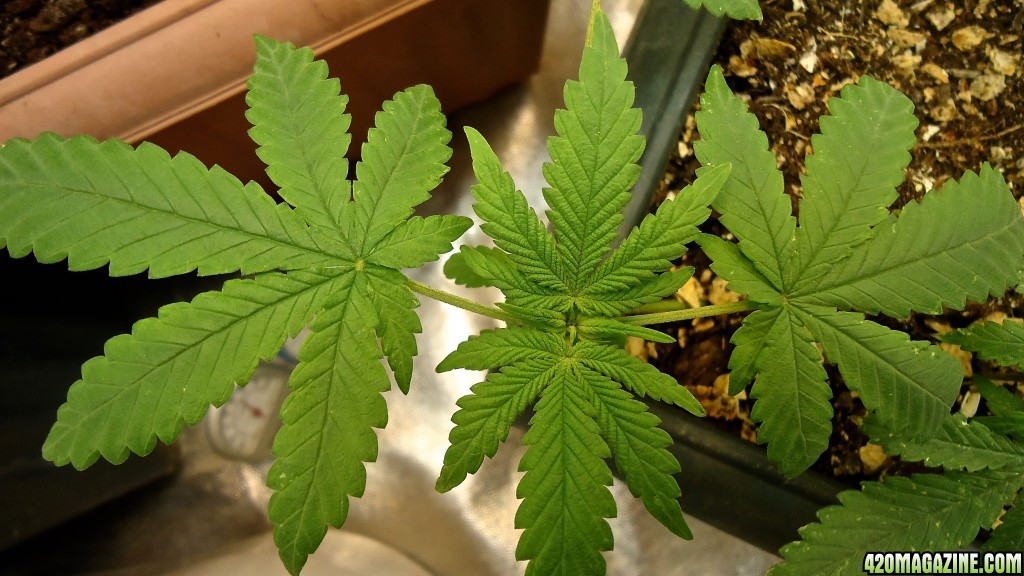
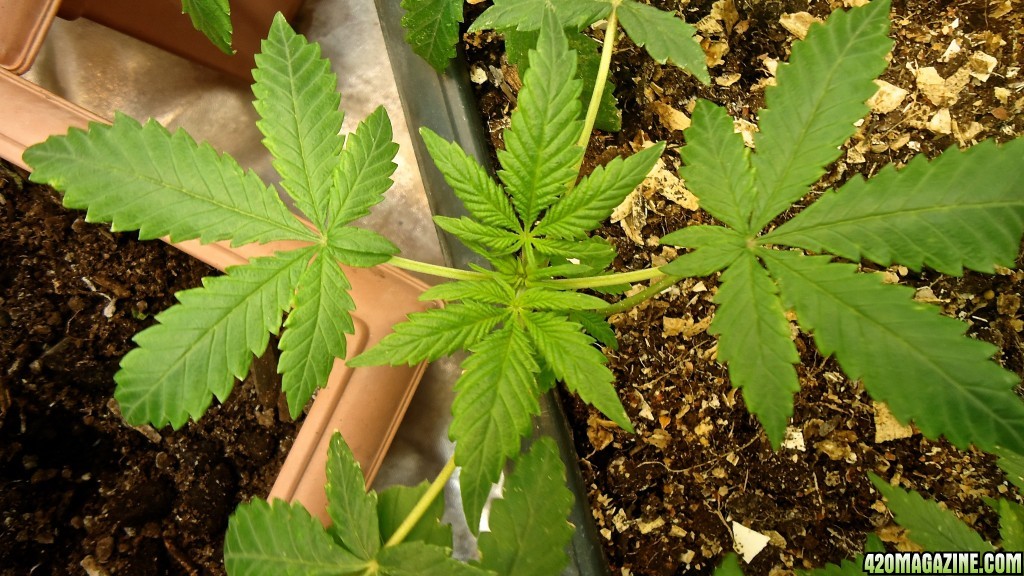
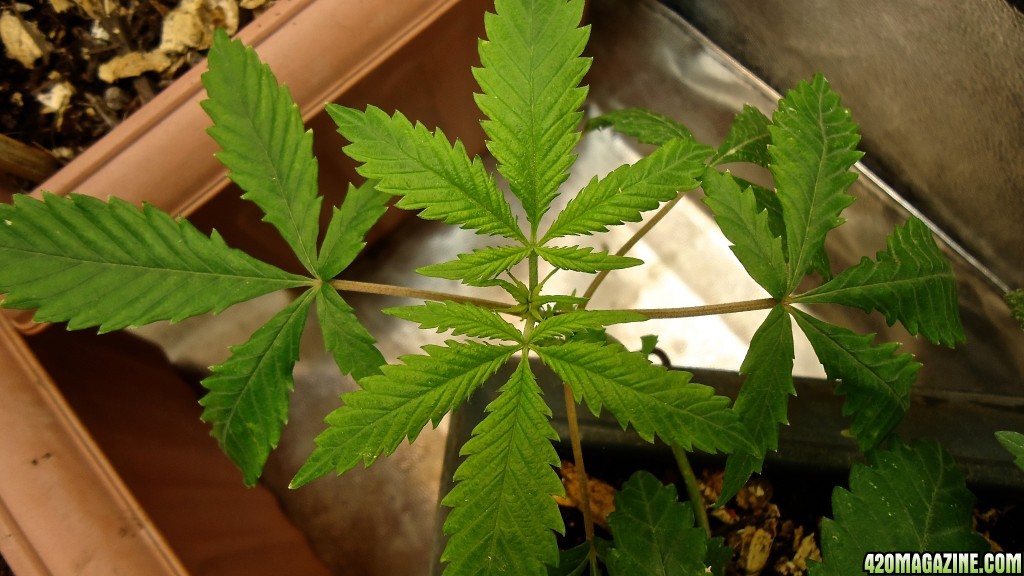
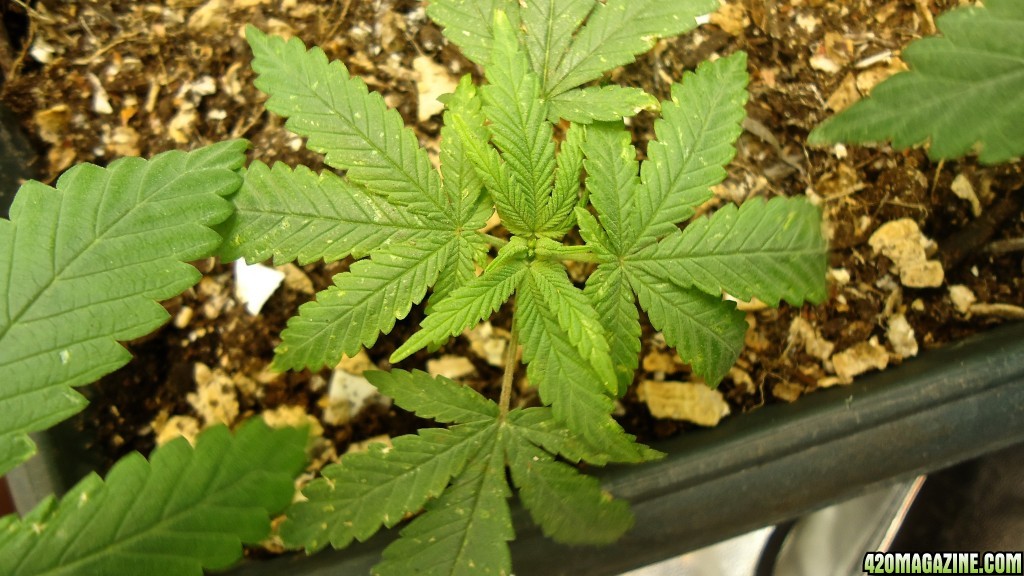
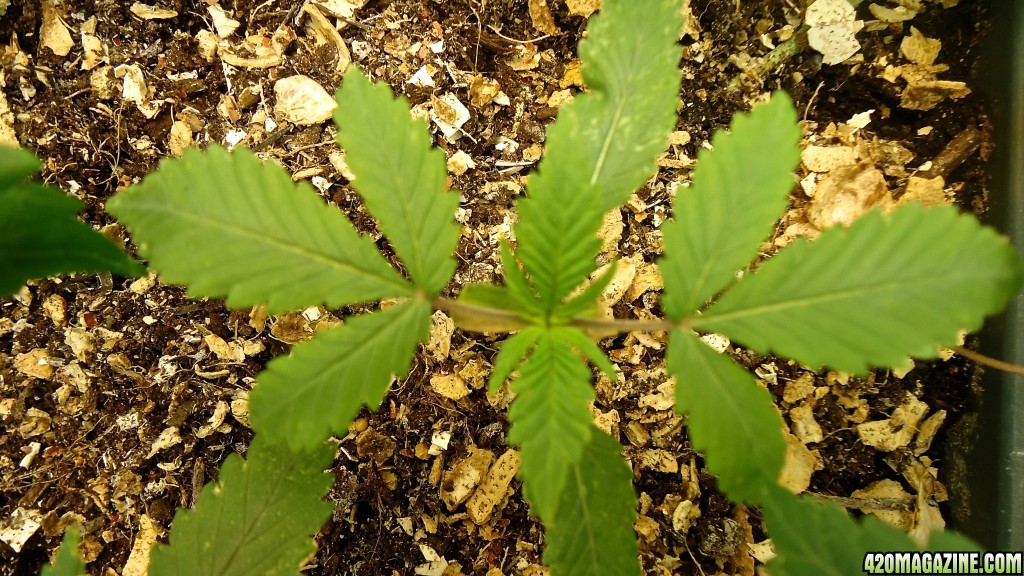
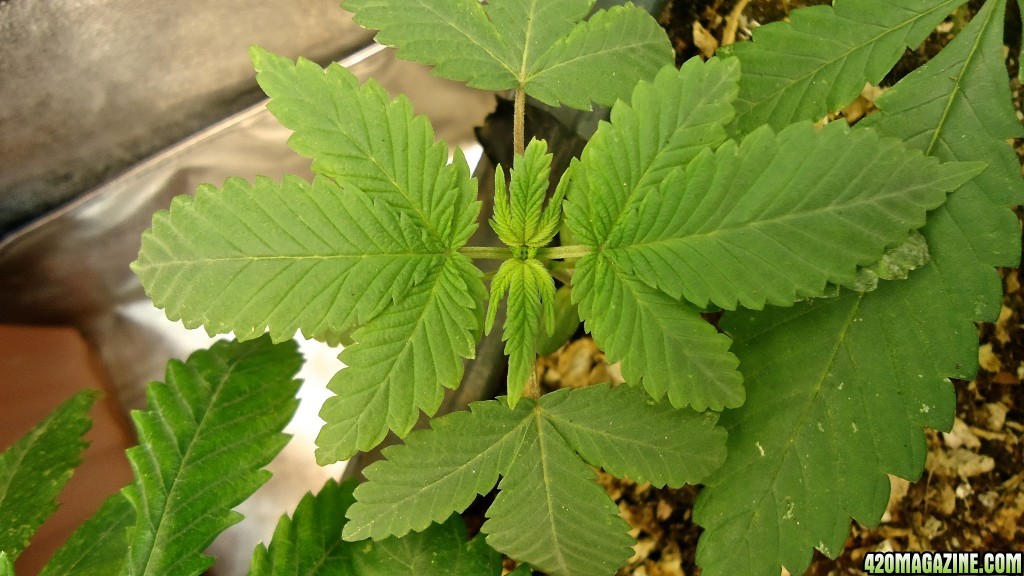
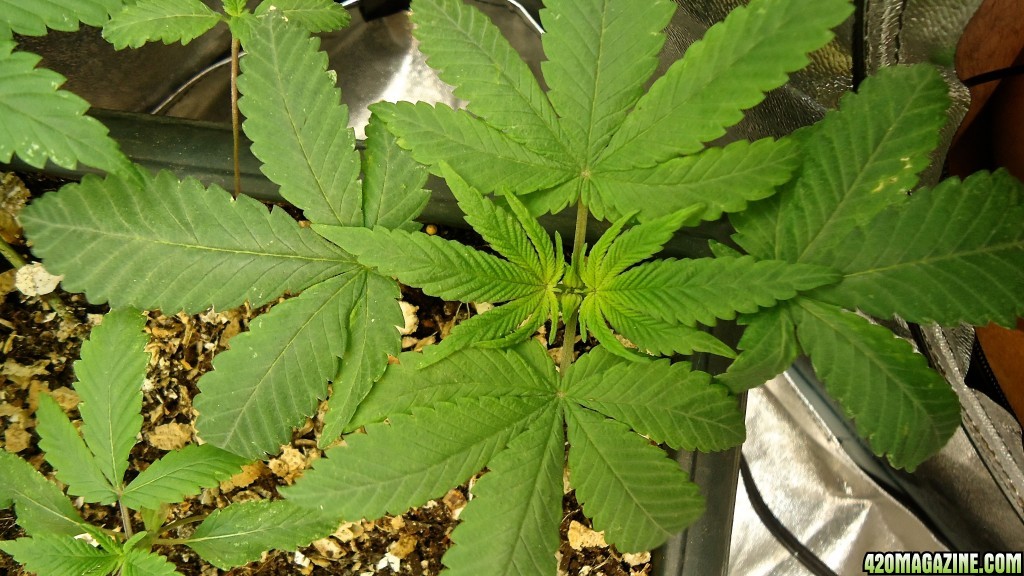
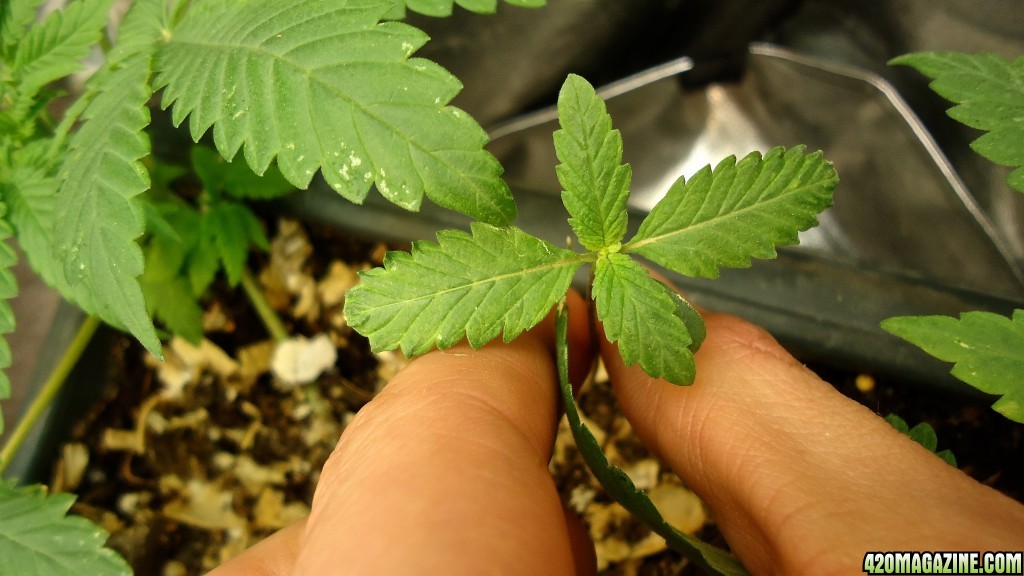
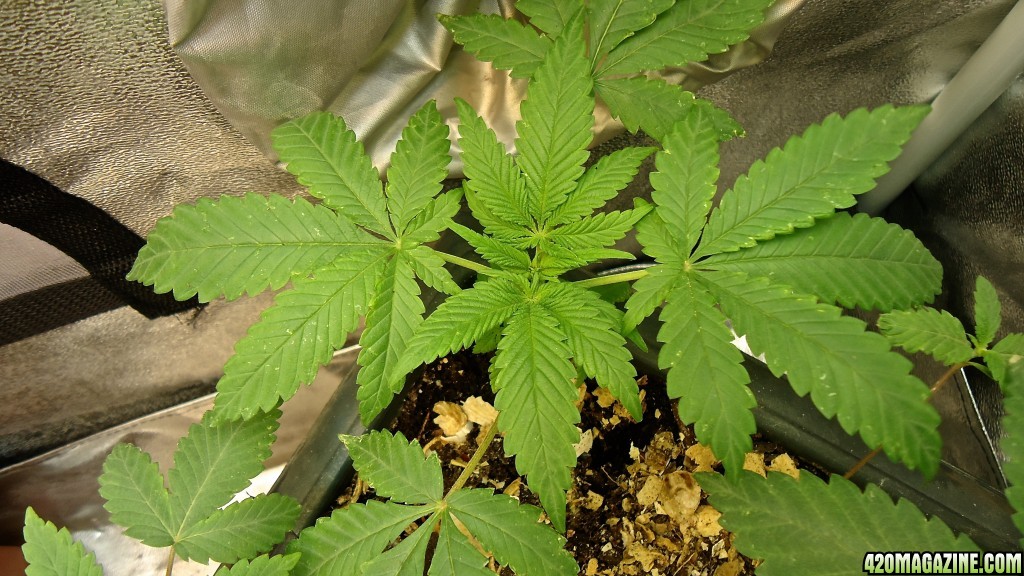
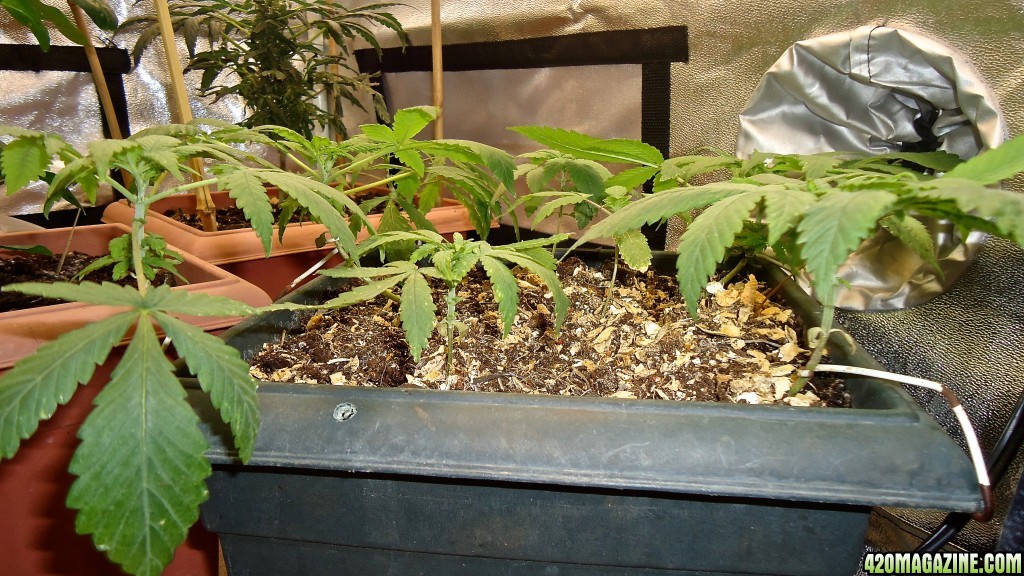
Now for the more older plant the BB a little over 2 months now, visible difference; the new growth is only 1-3 leaflet leaves, most develop trichomes that seem to cover the full extent of the leaf and stem. Also noticeable leaf necrosis starting from the bottom up and most predominant cell death in the most older leaves corresponding to the 5 leaflet leaves or the more older not well shaped leaf at the first 3 nodes, also there seems to be almost No development of visible trichomes in comparison with the top leaves and more recent growth. This pattern makes me believe that in fact this plant is in the senesces stage for the older leaves a typical hormonal change in plants that are ready for Autumn Bloom (usually turning yellow and naturally dying and falling off), but at the same time the build up of the flowering hormone is disrupted by the 14 hrs photoperiod, technically a full 12 hours photoperiod is the ultimate signal in mother Nature for the blooming cycle to start. Even more interesting is gonna be the next 30 days, Subtraction of 1 hour from the photoperiod and addition of UVA UVB radiation. Other detail lower branches seem to be growing upward like catching up with the main cola vs the main cola considerably slowed the upward growth. The dead leaves still have a very strong stem, pulling it doesn't break it off the stalk, the stem Is still very much alive but the cells in the leaf are dead or dying.
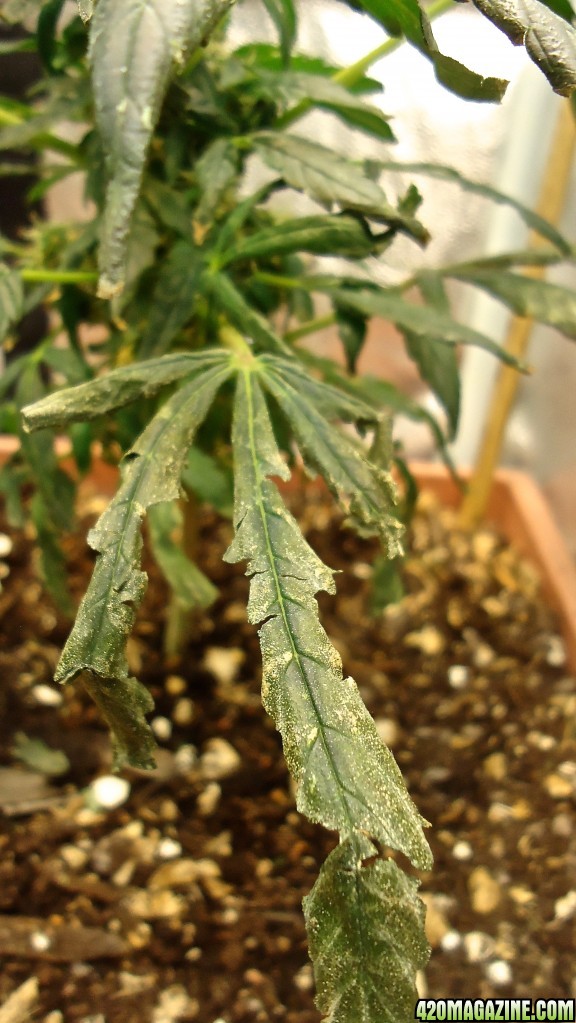
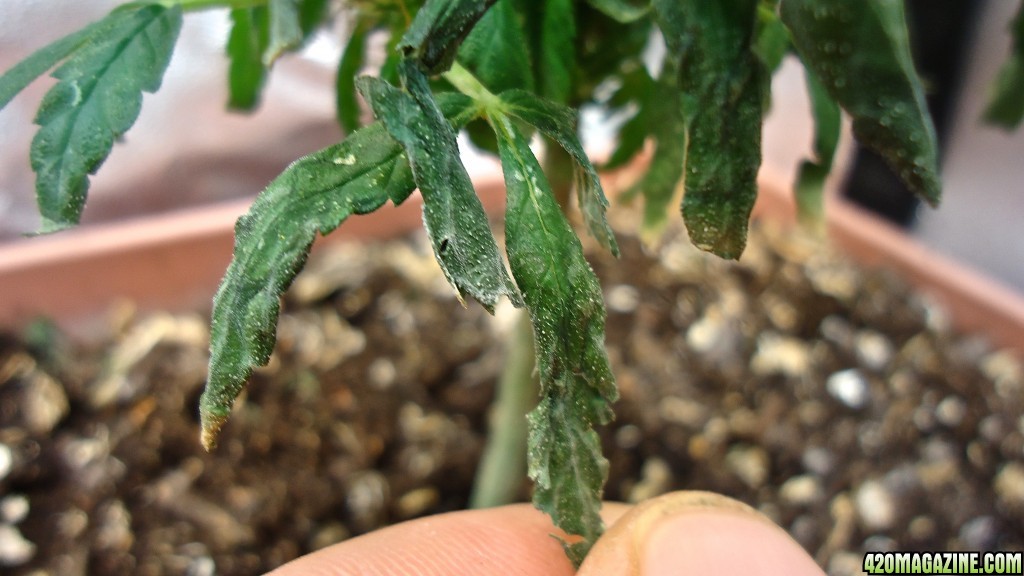
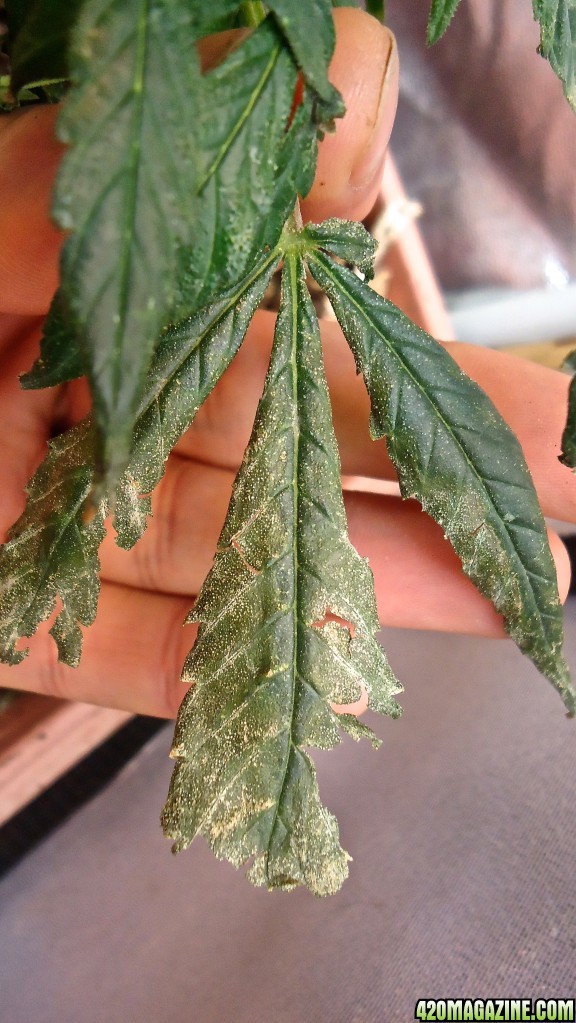
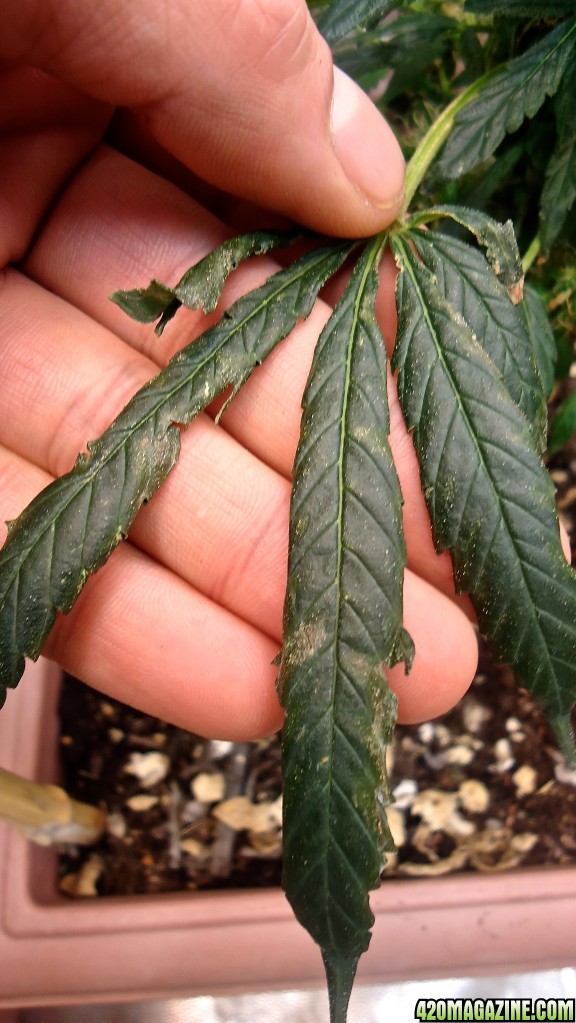
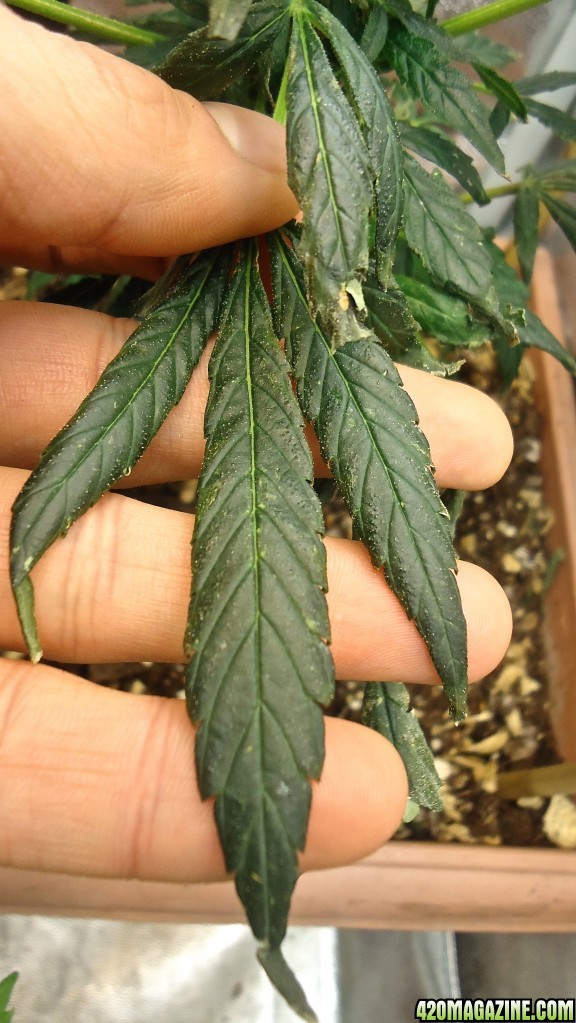
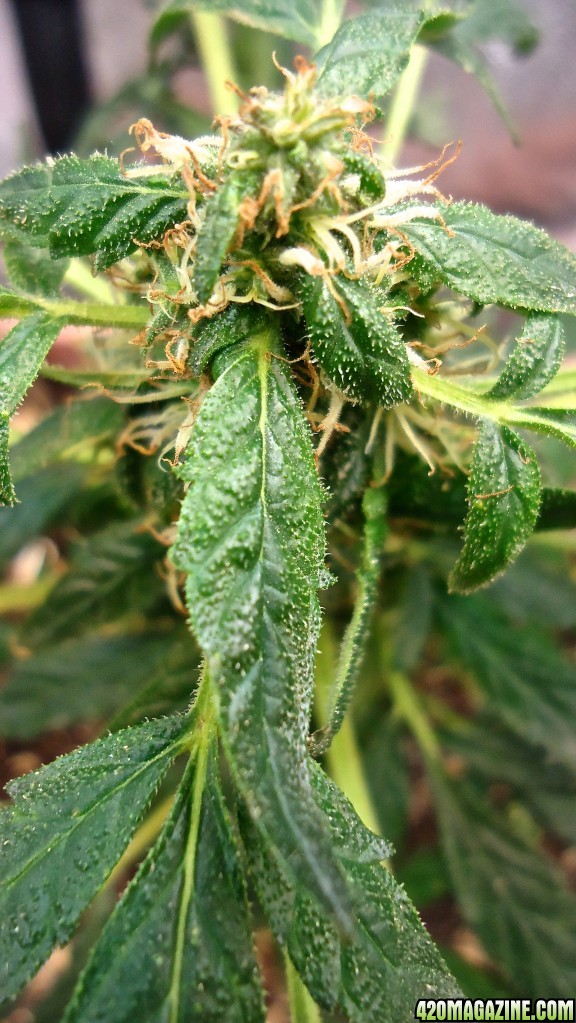
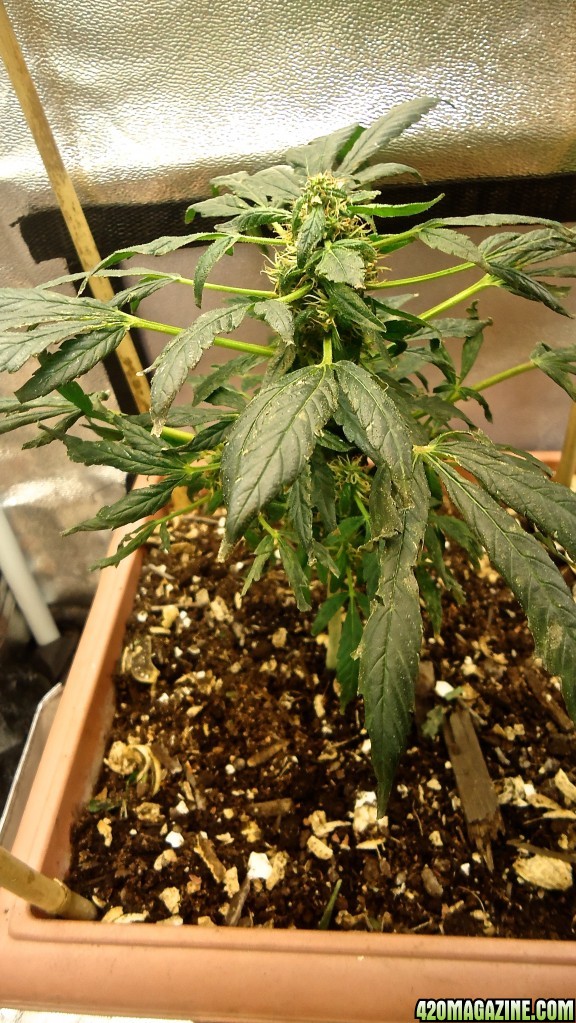
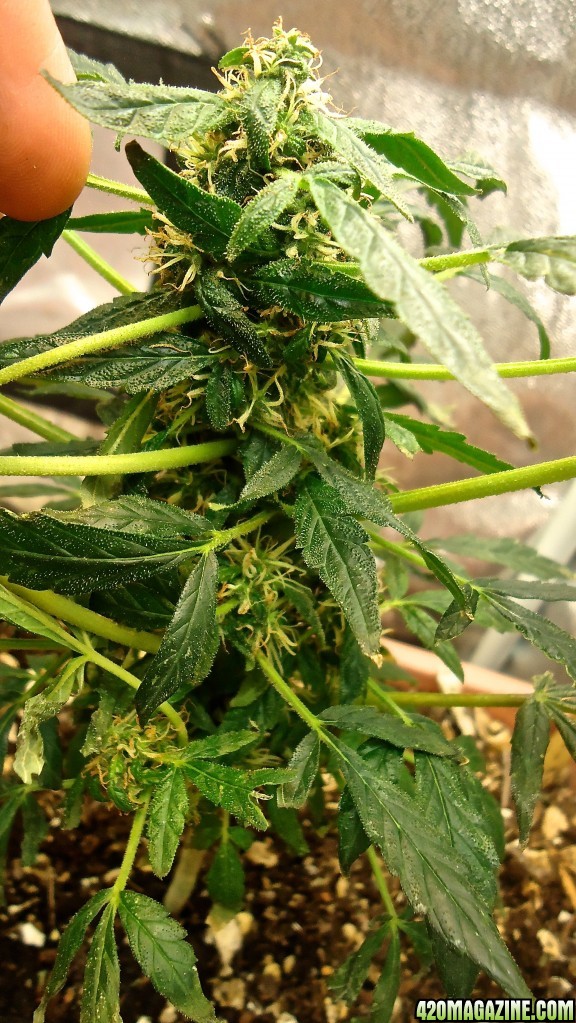
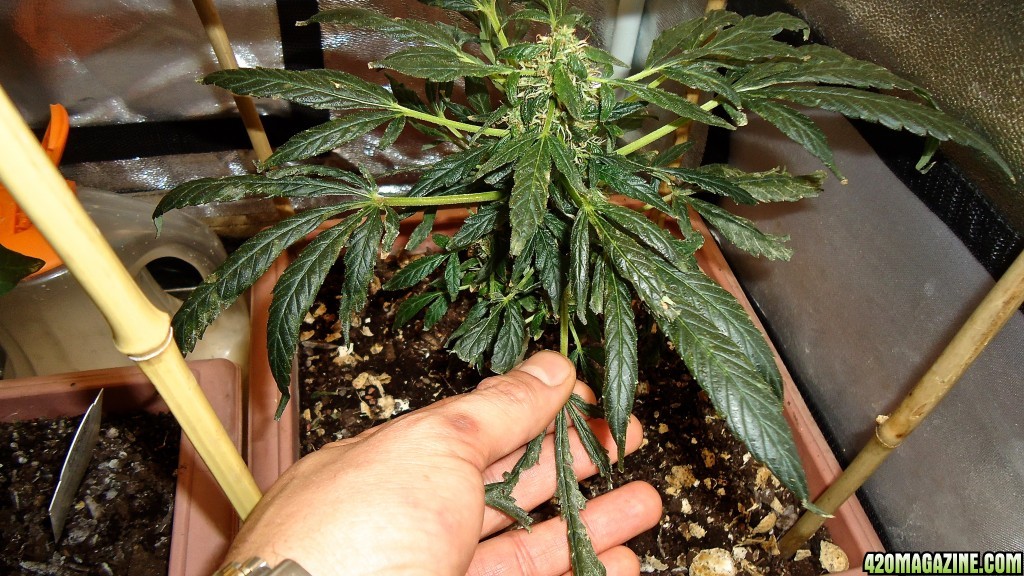
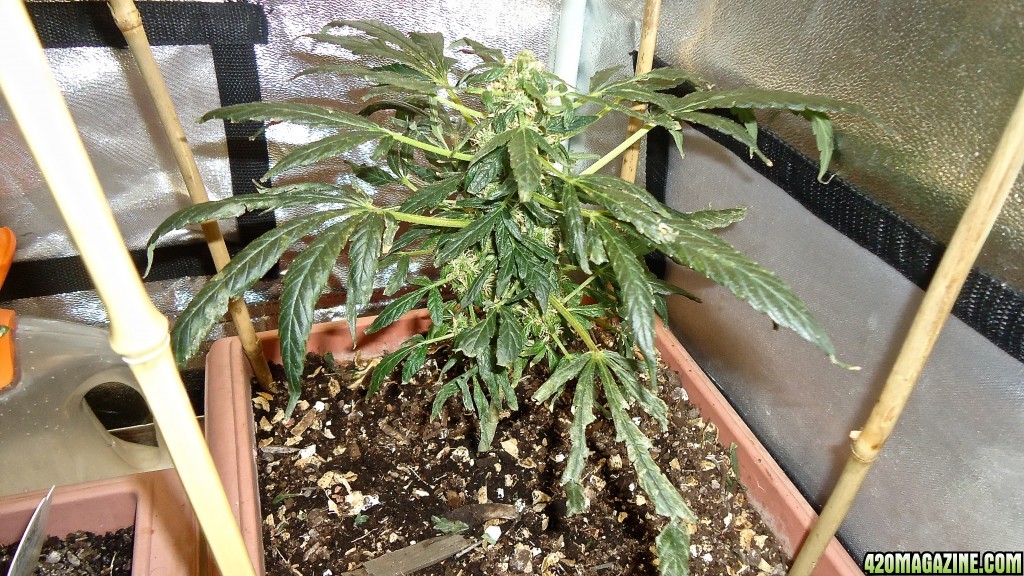
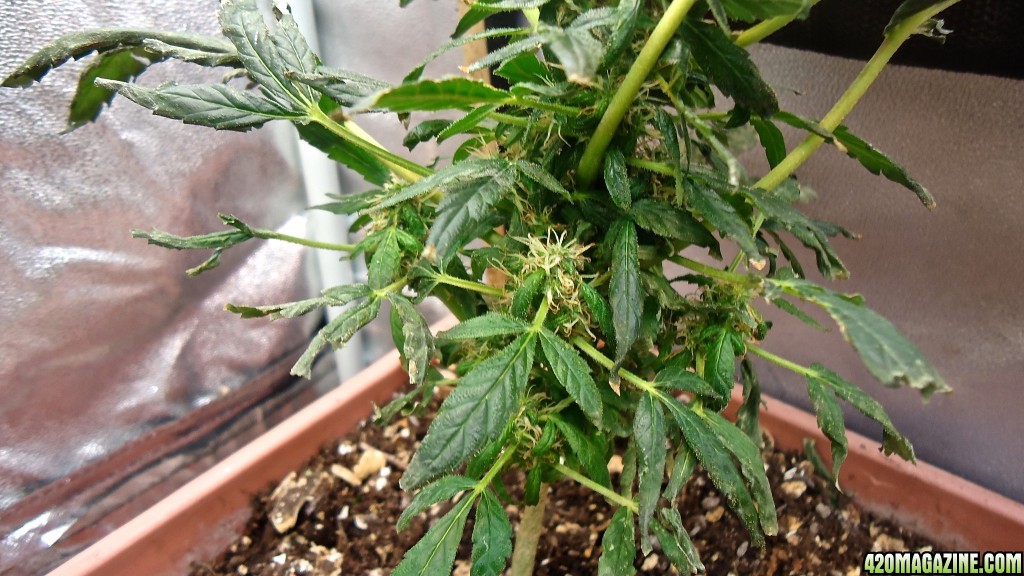
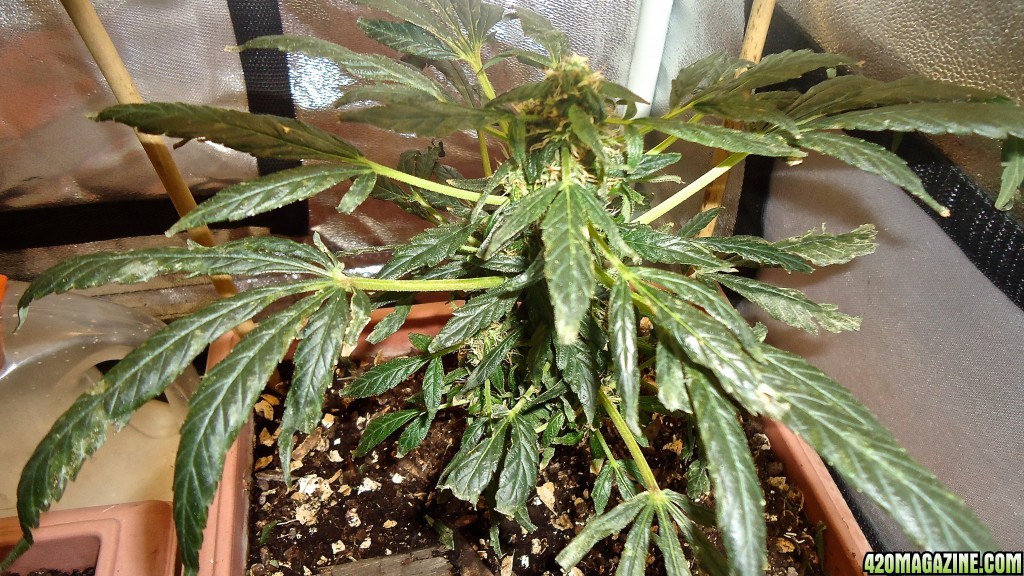
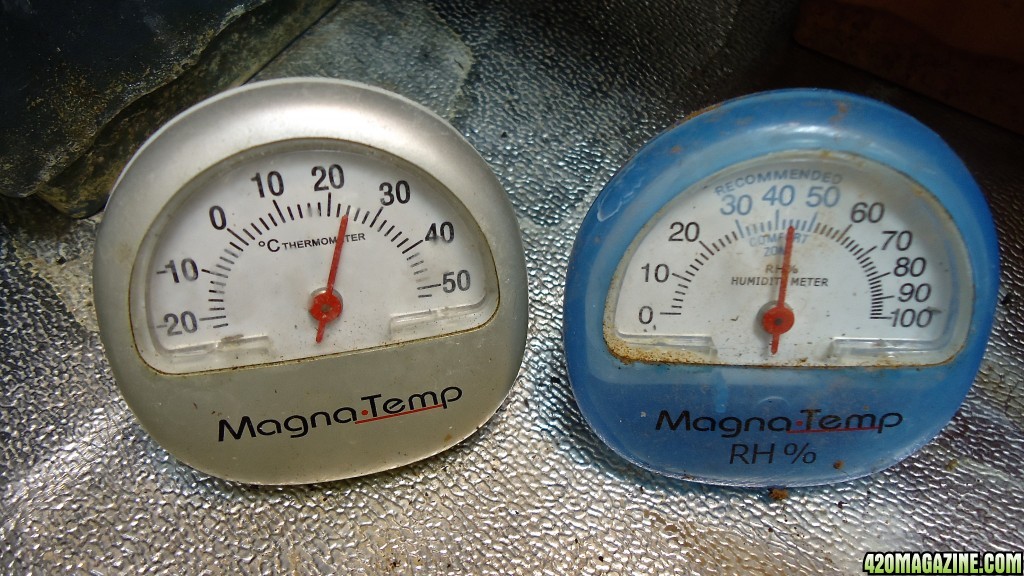
No watering until the end of the week, Fungus gnats are slim to none at this point. No larvae spotted within 2 inches deep in the soil. Carefully inspected all the plants looking for bugs or disease and I can seem to find anything BAD.
My intentions with all the alteration in the environment is to try improving the Quality of my meds rather than the Quantity of them. Better psychoactive meds mean less of a portion is needed to get the same effect, that said the exploration of THC is for more & better psychedelic high rather than a more therapeutic medicinal effect (CBD).
I want to show each individual phenotype, there are only 3 types of "genes" yet more than 3 different phenotype, they all look like different "strains". Very green, vibrant, each growing at their own pace, no signs of sex yet. Also no signs of 3 leaflet leaf, I could even count one fan leaf has 7 leaflet. So clearly these are all young plants still have not trigger flowering hormones to the mix, no visible trichome development at this point. First month
Now for the more older plant the BB a little over 2 months now, visible difference; the new growth is only 1-3 leaflet leaves, most develop trichomes that seem to cover the full extent of the leaf and stem. Also noticeable leaf necrosis starting from the bottom up and most predominant cell death in the most older leaves corresponding to the 5 leaflet leaves or the more older not well shaped leaf at the first 3 nodes, also there seems to be almost No development of visible trichomes in comparison with the top leaves and more recent growth. This pattern makes me believe that in fact this plant is in the senesces stage for the older leaves a typical hormonal change in plants that are ready for Autumn Bloom (usually turning yellow and naturally dying and falling off), but at the same time the build up of the flowering hormone is disrupted by the 14 hrs photoperiod, technically a full 12 hours photoperiod is the ultimate signal in mother Nature for the blooming cycle to start. Even more interesting is gonna be the next 30 days, Subtraction of 1 hour from the photoperiod and addition of UVA UVB radiation. Other detail lower branches seem to be growing upward like catching up with the main cola vs the main cola considerably slowed the upward growth. The dead leaves still have a very strong stem, pulling it doesn't break it off the stalk, the stem Is still very much alive but the cells in the leaf are dead or dying.
No watering until the end of the week, Fungus gnats are slim to none at this point. No larvae spotted within 2 inches deep in the soil. Carefully inspected all the plants looking for bugs or disease and I can seem to find anything BAD.
My intentions with all the alteration in the environment is to try improving the Quality of my meds rather than the Quantity of them. Better psychoactive meds mean less of a portion is needed to get the same effect, that said the exploration of THC is for more & better psychedelic high rather than a more therapeutic medicinal effect (CBD).
Positive vibes for the new year Danish, stay green  CA
CA
 CA
CA- Thread starter
- #52
Danishoes21
Well-Known Member
Positive vibes for the new year Danish, stay greenCA
Best Positives Vibes broda CA right back at you for the new year, keep'em green

- Thread starter
- #53
Danishoes21
Well-Known Member
Happy New Year 
Just small info update; photoperiods is now 13on-11off, temperature and RH% are stable. Today I watered the garden. The UVB lights should arrive next week.
till then


Just small info update; photoperiods is now 13on-11off, temperature and RH% are stable. Today I watered the garden. The UVB lights should arrive next week.
till then

Good evening weed danishoes. That last girl looks like she is have a hard time. Kind of like over watering but then again is kind of looks like a boron def. Very strange.. Anyway Happy New Year. 

- Thread starter
- #56
Danishoes21
Well-Known Member
I get what you're saying about the uv cfl. your plants are looking good despite the minor issues. happy growing
Thanks for the good vibes b. yeah the BlueBerry is a fighter, despite all the dead leaves some how a fresh batch is on the way. At this point I'm just observing, taking notes and letting do what she's gotta do...
will see what brings the next 30 days.
- Thread starter
- #57
Danishoes21
Well-Known Member
Good evening weed danishoes. That last girl looks like she is have a hard time. Kind of like over watering but then again is kind of looks like a boron def. Very strange.. Anyway Happy New Year.
Good Weed to you Bee and Happy New year
Yeah I gotta confess part of the reason Im dealing with minor fungus gnats is because I had overwatered for the whole first month of the grow session. So I think the BB got some of that in the system, I've corrected that in the past week I left them dry out completely to the point of tilt and today I watered for the first time.
Now on the Boron def. I really know very little about the looks of nutrient deficiency on Cannabis leaves (besides the most common ones like N) but, if it is indeed it is a Nut def. (suspected boron) why isn't it affecting the little ones? rather than what seems to be just the more oldest leaves on the oldest plant being the BB (now at a little over 2 months), I checked the whole plant today and a lot of new growth is coming maybe I could post some pics tomorrow, and there seems to be (visually) more abundance of trichomes, keep in mind this plant is supposed to "flower" officially at 12/12 and that is a month away from today.
So yeah Its very odd situation...
- Thread starter
- #59
Danishoes21
Well-Known Member

I have read a few Grow Journals where people supplemented with Reptisun UVB Florescent light bulbs, try searching for reptisun in the advanced search window at the top right of the webpage.
ReptiSun® 5.0 UVB Fluorescent
ReptiSun® 10.0 UVB
Plants grown under LED light panels have a higher requirement for calcium and magnesium. I believe the focused PAR spectrum activates more receptors in the plants than plants grown under High Pressure Sodium lights and causes higher amounts of calcium and magnesium to be used metabolically.
Many LED light panels also include Ultra Violet LED's in their designs and usage. Most charts are given in PAR meter readings for LED light panels. The PAR or Photosynthetic Active Radiation only covers from 400-700 nanometers and does not include either the UV or Infra Red wavelengths.
"Photosynthetically active radiation, often abbreviated PAR, designates the spectral range (wave band) of solar radiation from 400 to 700 nanometers that photosynthetic organisms are able to use in the process of photosynthesis. This spectral region corresponds more or less with the range of light visible to the human eye. Photons at shorter wavelengths tend to be so energetic that they can be damaging to cells and tissues, but are mostly filtered out by the ozone layer in the stratosphere. Photons at longer wavelengths do not carry enough energy to allow photosynthesis to take place.
Other living organisms, such as green bacteria, purple bacteria and Heliobacteria, can exploit solar light in slightly extended spectral regions, such as the near-infrared. These bacteria live in environments such as the bottom of stagnant ponds, sediment and ocean depths. Because of their pigments, they form colorful mats of green, red and purple.
Typical PAR action spectrum, shown beside absorption spectra for chlorophyll-A, chlorophyll-B, and carotenoids
Chlorophyll, the most abundant plant pigment, is most efficient in capturing red and blue light. Accessory pigments such as carotenes and xanthophylls harvest some green light and pass it on to the photosynthetic process, but enough of the green wavelengths are reflected to give leaves their characteristic color. An exception to the predominance of chlorophyll is autumn, when chlorophyll is degraded (because it contains N and Mg) but the accessory pigments are not (because they only contain C, H and O) and remain in the leaf producing red, yellow and orange leaves.
PAR measurement is used in agriculture, forestry and oceanography. One of the requirements for productive farmland is adequate PAR, so PAR is used to evaluate agricultural investment potential. PAR sensors stationed at various levels of the forest canopy measure the pattern of PAR availability and utilization. Photosynthetic rate and related parameters can be measured non-destructively using a photosynthesis system, and these instruments measure PAR and sometimes control PAR at set intensities. PAR measurements are also used to calculate the euphotic depth in the ocean"
Photosynthetically active radiation - Wikipedia, the free encyclopedia
ReptiSun® 5.0 UVB Fluorescent
ReptiSun® 10.0 UVB
The addition of UVB to the spectrum of led lights for example could be a great addition to the spectrum of light they emit, because there is a pattern I have seen in most of the LED grows on the site right now, is these light tend to cause a Ca and Mg deficiency... why? I haven't really gone deep into why the NEW leds cause this deficiencies.
Plants grown under LED light panels have a higher requirement for calcium and magnesium. I believe the focused PAR spectrum activates more receptors in the plants than plants grown under High Pressure Sodium lights and causes higher amounts of calcium and magnesium to be used metabolically.
Many LED light panels also include Ultra Violet LED's in their designs and usage. Most charts are given in PAR meter readings for LED light panels. The PAR or Photosynthetic Active Radiation only covers from 400-700 nanometers and does not include either the UV or Infra Red wavelengths.
"Photosynthetically active radiation, often abbreviated PAR, designates the spectral range (wave band) of solar radiation from 400 to 700 nanometers that photosynthetic organisms are able to use in the process of photosynthesis. This spectral region corresponds more or less with the range of light visible to the human eye. Photons at shorter wavelengths tend to be so energetic that they can be damaging to cells and tissues, but are mostly filtered out by the ozone layer in the stratosphere. Photons at longer wavelengths do not carry enough energy to allow photosynthesis to take place.
Other living organisms, such as green bacteria, purple bacteria and Heliobacteria, can exploit solar light in slightly extended spectral regions, such as the near-infrared. These bacteria live in environments such as the bottom of stagnant ponds, sediment and ocean depths. Because of their pigments, they form colorful mats of green, red and purple.
Typical PAR action spectrum, shown beside absorption spectra for chlorophyll-A, chlorophyll-B, and carotenoids
Chlorophyll, the most abundant plant pigment, is most efficient in capturing red and blue light. Accessory pigments such as carotenes and xanthophylls harvest some green light and pass it on to the photosynthetic process, but enough of the green wavelengths are reflected to give leaves their characteristic color. An exception to the predominance of chlorophyll is autumn, when chlorophyll is degraded (because it contains N and Mg) but the accessory pigments are not (because they only contain C, H and O) and remain in the leaf producing red, yellow and orange leaves.
PAR measurement is used in agriculture, forestry and oceanography. One of the requirements for productive farmland is adequate PAR, so PAR is used to evaluate agricultural investment potential. PAR sensors stationed at various levels of the forest canopy measure the pattern of PAR availability and utilization. Photosynthetic rate and related parameters can be measured non-destructively using a photosynthesis system, and these instruments measure PAR and sometimes control PAR at set intensities. PAR measurements are also used to calculate the euphotic depth in the ocean"
Photosynthetically active radiation - Wikipedia, the free encyclopedia
Similar threads
- Replies
- 819
- Views
- 51K
- Replies
- 91
- Views
- 17K
- Replies
- 373
- Views
- 20K
- Replies
- 220
- Views
- 17K


